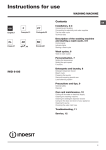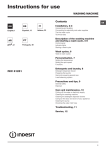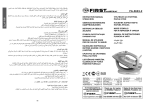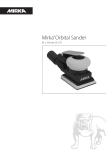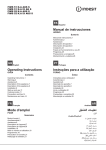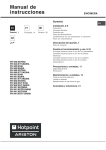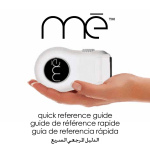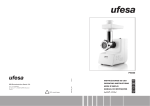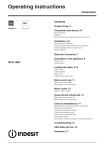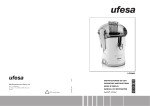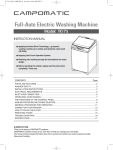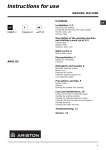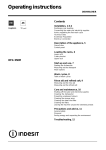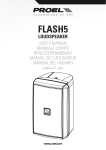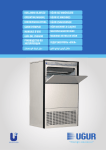Download Instructions for use
Transcript
Instructions for use WASHER-DRYER ! F GB English,1 Français,15 AR This symbol reminds you to read this instruction manual. GB Contents , 29 Installation, 2-3-4-5 Unpacking and levelling Connecting the electricity and water supplies The first wash cycle Technical data Description of the washer-dryer and starting a wash cycle, 6-7 Control panel Indicator lights Starting a wash cycle Wash cycles, 8 Table of wash cycles IWDC 7085 Personalisation, 9 Setting the temperature Setting the drying cycle Functions Detergents and laundry, 10 Detergent dispenser drawer Preparing the laundry Garments requiring special care Load balancing system Precautions and tips, 11 General safety Disposal Care and maintenance, 12 Cutting off the water or electricity supply Cleaning the washer-dryer Cleaning the detergent dispenser drawer Caring for the door and drum of your appliance Cleaning the pump Checking the water inlet hose Troubleshooting, 13 Service, 14 1 Installation GB ! This instruction manual should be kept in a safe place for future reference. If the washer-dryer is sold, transferred or moved, make sure that the instruction manual remains with the machine so that the new owner is able to familiarise himself/herself with its operation and features. ! Read these instructions carefully: they contain vital infor- Levelling the machine correctly will provide it with stability, help to avoid vibrations and excessive noise and prevent it from shifting while it is operating. If it is placed on carpet or a rug, adjust the feet in such a way as to allow a sufficient ventilation space underneath the washer-dryer. mation relating to the safe installation and operation of the appliance. Connecting the electricity and water supplies Unpacking and levelling Connecting the water inlet hose Unpacking 1. Remove the washer-dryer from its packaging. 2. Make sure that the washer-dryer has not been damaged during the transportation process. If it has been damaged, contact the retailer and do not proceed any further with the installation process. 3. Remove the 4 protective screws (used during transportation) and the rubber washer with the corresponding spacer, located on the rear part of the appliance (see figure). 1. Connect the supply pipe by screwing it to a cold water tab using a ¾ gas threaded connection (see figure). Before performing the connection, allow the water to run freely until it is perfectly clear. 2. Connect the inlet hose to the washer-dryer by screwing it onto the corresponding water inlet of the appliance, which is situated on the top right-hand side of the rear part of the appliance (see figure). 4. Close off the holes using the plastic plugs provided. 5. Keep all the parts in a safe place: you will need them again if the washer-dryer needs to be moved to another location. 3. Make sure that the hose is not folded over or bent. ! Packaging materials should not be used as toys for children. ! The water pressure at the tap must fall within the values indicated in the Technical details table (see next page). Levelling ! If the inlet hose is not long enough, contact a specialised shop or an authorised technician. 1. Install the washer-dryer on a flat sturdy floor, without resting it up against walls, furniture cabinets or anything else. 2. If the floor is not perfectly level, compensate for any unevenness by tightening or loosening the adjustable front feet (see figure); the angle of inclination, measured in relation to the worktop, must not exceed 2°. 2 ! Never use second-hand hoses. ! Use the ones supplied with the machine. Connecting the drain hose 65 - 100 cm Connect the drain hose, without bending it, to a draining duct or a wall drain situated between 65 and 100 cm from the floor; alternatively, place it over the edge of a basin, sink or tub, fastening the duct supplied to the tap (see figure). The free end of the hose should not be underwater. ! We advise against the use of hose extensions; in case of absolute need, the extension must have the same diameter as the original hose and must not exceed 150 cm in length. Electric connection Before plugging the appliance into the mains socket, make sure that: • the socket is earthed and in compliance with the applicable law; • the socket is able to sustain the appliance’s maximum power load indicated in the Technical details table (see page 5); Replacing the fuse: When replacing a faulty fuse, a 13 amp ASTA approved fuse to BS 1362 should always be used, and the fuse cover re-fitted. If the fuse cover is lost, the plug must not be used until a replacement is obtained. Replacement fuse covers: If a replacement fuse cover is fitted, it must be of the correct colour as indicated by the coloured marking or the colour that is embossed in words on the base of the plug. Replacements can be obtained directly from your nearest Service Depot. Removing the plug: If your appliance has a non-rewireable moulded plug and you should wish to re-route the mains cable through partitions, units etc., please ensure that either: the plug is replaced by a fused 13 ampere re-wearable plug bearing the BSI mark of approval. or: the mains cable is wired directly into a 13 amp cable outlet, controlled by a switch, (in compliance with BS 5733) which is accessible without moving the appliance. Disposing of the plug: Ensure that before disposing of the plug itself, you make the pins unusable so that it cannot be accidentally inserted into a socket. Instructions for connecting cable to an alternative plug: Important: the wires in the mains lead are coloured in accordance with the following code: Green & Yellow Earth Blue Neutral Brown Live As the colours of the wires in the lead may not correspond with the coloured markings identifyng the terminals in your plug, proceed as follows: Connect Green & Yellow wire to terminal marked E or or coloured Green or Green & Yellow. Connect Brown wire to terminal marked L or coloured Red. Connect Blue wire to terminal marked N or coloured Black. • the supply voltage is included within the values i ndicated on the Technical details table (see page 5); • the socket is compatible with the washing machine’s plug. If this is not the case, replace the socket or the plug. Your appliance is now supplied with a 13 amp fused plug it can be plugged into a 13 amp socket for immediate use. Before using the appliance please read the instructions below. WARNING - THIS APPLIANCE MUST BE EARTHED. THE FOLLOWING OPERATIONS SHOULD BE CARRIED OUT BY A QUALIFIED ELECTRICIAN. 3 GB GB If a 13 amp plug (BS 1363) is used it must be fitted with a 13 amp fuse, either in the plug or adaptor or at the distribution board. If you are in any doubt the electrical supply to your machine, consult a qualified electrician before use. How to connect an alternative plug: The wires in this mains lead are coloured in accordance with the following code: BLUE NEUTRAL (N) BROWN LIVE (L) GREEN & YELLOW EARTH (E) Disposing of the appliance: When disposing of the appliance please remove the plug by cutting the mains cable as close as possible to the plug body and dispose of it as described above. GREEN & YELLOW BROWN BLUE 13 ampere fuse CROSS-BAR CORD GRIP ! The washing machine should not be installed in an outdoor environment, not even when the area is sheltered, because it may be very dangerous to leave it exposed to rain and thunderstorms. ! When the washing machine is installed, the mains socket must be within easy reach. ! Do not use extensions or multiple sockets. ! The power supply cable must never be bent or dangerously compressed. ! The power supply cable must only be replaced by an authorised serviceman. Warning! The company denies all liability if and when these norms are not respected. 4 The first wash cycle Once the appliance has been installed, and before you use it for the first time, run a wash cycle with detergent and no laundry, using the wash cycle 2. Technical data Model IWDC 7085 Dimensions width 59.5 cm height 85 cm depth 53,5 cm Capacity from 1 to 7 kg for the wash programme; from 1 to 5 kg for the drying programme Electrical connections please refer to the technical data plate fixed to the machine Water connections maximum pressure 1 MPa (10 bar) minimum pressure 0.05 MPa (0.5 bar) drum capacity 52 litres Spin speed up to 800 rotations per minute Energy rated programmes according to regulation EN 50229 Wash: programme 2; temperature 60°C; run with a load of 7 kg. Drying: first drying cycle performed with a 2 kg load and the DRYING knob on the setting; Second drying cycle performed with a 5 kg load and the DRYING knob on the setting. GB This appliance conforms to the following EC Directives: - 89/336/EEC dated 03/05/89 (Electromagnetic Compatibility) and subsequent modifications - 2002/96/EC - 2006/95/EC Low Voltage) 5 Description of the washer-dryer and starting a wash cycle GB Control panel WASH CYCLE PROGRESS/ DELAY TIMER indicator lights FUNCTION ON/OFF button buttons with indicator lights TEMPERATURE Detergent dispenser drawer knob Detergent dispenser drawer: used to dispense detergents and washing additives (see “Detergents and laundry”). ON/OFF button: switches the washer-dryer on and off. WASH CYCLE knob: programmes the wash cycles. During the wash cycle, the knob does not move. FUNCTION buttons with indicator light: used to select the available functions. The indicator light corresponding to the selected function will remain lit. TEMPERATURE knob: sets the temperature or the cold wash cycle (see “Personalisation”). DRYING knob: used to set the desired drying programme (see “Personalisation”). WASH CYCLE PROGRESS/DELAY TIMER indicator lights: used to monitor the progress of the wash cycle. The illuminated indicator light shows which phase is in progress. If the Delay Timer function has been set, the time remaining until the wash cycle starts will be indicated (see next page). DOOR LOCKED indicator light: indicates whether the door may be opened or not (see next page). 6 button with indicator light DOOR LOCKED knob WASH CYCLE START/ PAUSE DRYING indicator light knob START/PAUSE button with indicator light: starts or temporarily interrupts the wash cycles. N.B. To pause the wash cycle in progress, press this button; the corresponding indicator light will flash orange, while the indicator light for the current wash cycle phase will remain lit in a fixed manner. If the DOOR LOCKED indicator light is switched off, the door may be opened. To start the wash cycle from the point at which it was interrupted, press this button again. Standby mode This washing machine, in compliance with new energy saving regulations, is fitted with an automatic standby system which is enabled after about 30 minutes if no activity is detected. Press the ON-OFF button briefly and wait for the machine to start up again. Indicator lights The indicator lights provide important information. This is what they can tell you: Delayed start If the DELAY TIMER function has been activated (see “Personalisation”), after the wash cycle has been started the indicator light corresponding to the selected delay period will begin to flash: Wash cycle phase indicator lights Once the desired wash cycle has been selected and has begun, the indicator lights switch on one by one to indicate which phase of the cycle is currently in progress. Wash Rinse Spin/Drain Drying End of wash cycle Note: when the drying cycle has finished, the DRYING knob should be returned to the “0” position. As time passes, the remaining delay will be displayed and the corresponding indicator light will flash: The set programme will start once the selected time delay has expired. Function buttons and corresponding indicator lights When a function is selected, the corresponding indicator light will illuminate. If the selected function is not compatible with the programmed wash cycle, the corresponding indicator light will flash and the function will not be activated. If the selected function is not compatible with another function which has been selected previously, the indicator light corresponding to the first function selected will flash and only the second function will be activated; the indicator light corresponding to the enabled option will remain lit. Door locked indicator light When the indicator light is on, the porthole door is locked to prevent it from being opened; make sure the indicator light is off before opening the door (wait approximately 3 minutes). To open the door during a running wash cycle, press the START/PAUSE button; the door may be opened once the DOOR LOCKED indicator light turns off. Starting a wash cycle 1. Switch the washer-dryer on by pressing the ON/OFF button. All indicator lights will switch on for a few seconds, then they will switch off and the START/PAUSE indicator light will pulse. 2. Load the laundry and close the door. 3. Set the WASH CYCLE knob to the desired programme. 4. Set the washing temperature (see “Personalisation”). 5. Set the drying cycle if necessary (see “Personalisation”). 6. Measure out the detergent and washing additives (see “Detergents and laundry”). 7. Select the desired functions. 8. Start the wash cycle by pressing the START/PAUSE button and the corresponding indicator light will remain lit in a fixed manner, in green. To cancel the set wash cycle, pause the machine by pressing the START/PAUSE button and select a new cycle. indicator light will switch on. The door can be opened once the DOOR LOCKED 9. At the end of the wash cycle the indicator light turns off. Take out your laundry and leave the appliance door ajar to make sure the drum dries completely. Switch the washer-dryer off by pressing the ON/OFF button. 7 GB Wash cycles Table of wash cycles Wash cycles GB Description of the wash cycle Detergents Max. Max. temp. speed Drying Main Fabric (°C) (rpm) Prewash wash softener Max. load (kg) Cycle duration Daily 1 Cotton with prewash: extremely soiled whites. 90° 800 7 171’ 2 Cotton: extremely soiled whites. 90° 800 - 7 155’ 2 Cotton (1): heavily soiled whites and resistant colours. 60° 800 - 7 153’ 2 Cotton (2): lightly soiled whites and delicate colours. 40° 800 - 7 147’ 3 Cotton: heavily soiled whites and resistant colours. 60° 800 - 7 130’ 4 Coloured Cotton: lightly soiled whites and delicate colours. 40° 800 - 7 92’ 5 Synthetics: lightly soiled resistant colours. 60° 800 - 3 85’ Special 6 Wool: for wool, cashmere, etc. 40° 600 - - 1,5 55’ 7 Silk/Curtains: for garments in silk and viscose, lingerie. 30° 0 - - 1 55’ 8 Jeans 40° 800 - 3 80’ 9 Sport Light 30° 600 - - 68 10 Sport Shoes 30° 600 - - 3 Max. 2 pairs 11 Cotton dry - - - - - 5 - 12 Synthetics dry - - - - - 3 - 30° 800 - 0,5 35’ Rinse - 800 - - 7 36 Spin - 800 - - - 7 16 Drain - 0 - - - - 7 2 50’ Drying 13 Express Wash & Dry Partial wash cycles The information contained in the table is intended as a guide only. For all Test Institutes: 1) Test wash cycle in compliance with regulation EN 50229: set wash cycle 2 with a temperature of 60°C. 2) Long wash cycle for cottons: set wash cycle 2 with a temperature of 40°C. Specials wash cycles Sport Light (wash cycle 9) is for washing lightly soiled sports clothing fabrics (tracksuits, shorts, etc.); for best results, we recommend not exceeding the maximum load indicated in the “Table of wash cycles”. We recommend using a liquid detergent and dosage suitable for a half-load. Sport Shoes (wash cycle 10) is for washing sports shoes; for best results, do not wash more than 2 pairs (fabric) simultaneously. Express Wash & Dry (wash cycle 13) was designed to wash and dry lightly soiled garments quickly. This cycle may be used to wash and dry a laundry load of up to 0.5 kg in just 35 minutes. To achieve optimum results, use liquid detergent and pre-treat cuffs, collars and stains. 8 Personalisation Setting the temperature Turn the TEMPERATURE knob to set the wash temperature (see Table of wash cycles). The temperature may be lowered, or even set to a cold wash . The washer-dryer will automatically prevent you from selecting a temperature which is higher than the maximum value set for each wash cycle. Setting the drying cycle Table of Drying times (guideline values) Turn the DRYING knob to select the desired drying Fabric Max. Cupboard Henger Iron Load type option. There are two options: type load (kg) dry dry dry A - Based on time: From 40 minutes to 180. Clothing of diffeB - Based on the desired laundry dryness level: Cotton rent sizes, Terry 5 250 210 190 Iron dry : suitable for clothes which will need ironing towels afterwards. the remaining dampness softens creases, making them easier to remove. Synthe- Sheets, Shirts, Py3 180 130 115 : ideal for clothes which do not need to Hanger dry jamas, socks, etc. tics be dried fully. Cupboard dry : suitable for laundry which can be put back in a cupboard without being ironed. If your laundry load to be washed and dried is much greater than the maximum stated load (see adjacent table), perform the wash cycle, and when the cycle is complete, divide the garments into groups and put some of them back in the drum. At this point, follow the instructions provided for a “Drying only” cycle. Repeat this procedure for the remainder of the load. Drying only Use the cycle selector knob to select a drying cycle (11-12) in accordance with the type of fabric. The desired drying level or time may also be set using the DRYING knob. Functions The various wash functions available with this washer-dryer will help to achieve the desired results, every time. To activate the functions: 1. Press the button corresponding to the desired function; 2. the function is enabled when the corresponding indicator light is illuminated. Note: - If the selected function is not compatible with the programmed wash cycle, the corresponding indicator light will flash and the function will not be activated. - If the selected function is not compatible with another function which has been selected previously, the indicator light corresponding to the first function selected will flash and only the second function will be activated; the indicator light corresponding to the enabled option will remain lit. Selecting this option enables you to suitably adjust drum rotation, temperature and water to a reduced load of lightly soiled cotton and synthetic fabrics (refer to the “Table of wash cycles”). “ ” enables you to wash in less time thereby saving water and electricity. We suggest using a liquid detergent suitably measured out to the load quantity. 800-400 Press this button to reduce the spin speed. Easy iron By selecting this function, the wash and spin cycles will be modified in order to reduce the formation of creases. At the end of the cycle the Washer-dryer will perform slow rotations of the drum; the indicator lights for the EASY IRON and START/PAUSE options will flash (the first one green, the second orange) and the “END” indicator light turns on. To end the cycle, press the START/PAUSE button or the EASY IRON button. For the 7 wash cycle, the machine will end the cycle while the laundry is soaking and the EASY IRON and START/PAUSE indicator lights will flash. To drain the water so that the laundry may be removed, press the START/PAUSE button or the EASY IRON button. (Iron dry). Note: If you also want to run the drying cycle, this option is enabled only if combined with level Delay timer This timer delays the start time of the wash cycle by up to 9 hours. Press the button repeatedly until the indicator light corresponding to the desired delay time switches on. The fourth time the button is pressed, the function will be disabled. N.B. Once the START/PAUSE button has been pressed, the delay time can only be modified by decreasing it until launching the set programme. 9 GB Detergents and laundry GB Detergent dispenser drawer Good washing results also depend on the correct dose of detergent: adding too much detergent will not necessarily result in a more efficient wash, and may in fact cause build up on the inside of your appliance and contribute to environmental pollution. ! Do not use hand washing detergents because these create too much foam. Open the detergent dispenser drawer and pour in the detergent or washing additive, as follows. 1 2 3 compartment 1: Pre-wash detergent (powder) compartment 2: Detergent for the wash cycle (powder or liquid) Liquid detergent should only be poured in immediately prior to the start of the wash cycle. compartment 3: Additives (fabric softeners, etc.) The fabric softener should not overflow the grid. Preparing the laundry • Divide the laundry according to: - the type of fabric/the symbol on the label - the colours: separate coloured garments from whites. • Empty all garment pockets and check the buttons. • Do not exceed the listed values, which refer to the weight of the laundry when dry: Durable fabrics: max. 7 kg Synthetic fabrics: max. 3 kg Delicate fabrics: max. 2 kg Wool: max. 1,5 kg Silk: max. 1 kg How much does your laundry weigh? 1 sheet 400-500 g 1 pillow case 150-200 g 1 tablecloth 400-500 g 1 bathrobe 900-1200 g 1 towel 150-250 g Garments requiring special care Wool: all wool garments can be washed using programme 6, even those carrying the “hand-wash only” label. For best results, use special detergents and do not exceed 1,5 kg of laundry. 10 Silk: use special wash cycle 7 to wash all silk garments. We recommend the use of special detergent which has been designed to wash delicate clothes. Curtains: fold curtains and place them in a pillow case or mesh bag. Use wash cycle 7. Jeans: Turn garments inside-out before washing and use a liquid detergent. Use programme 8. Load balancing system Before every spin cycle, to avoid excessive vibrations and to distribute the load in a uniform manner, the drum rotates continuously at a speed which is slightly greater than the washing rotation speed. If, after several attempts, the load is not balanced correctly, the machine spins at a reduced spin speed. If the load is excessively unbalanced, the washer-dryer performs the distribution process instead of spinning. To encourage improved load distribution and balance, we recommend small and large garments are mixed in the load. Precautions and tips ! This washer-dryer was designed and constructed in accordance with international safety regulations. The following information is provided for safety reasons and must therefore be read carefully. General safety • This appliance was designed for domestic use only. • This appliance is not intended for use by persons (including children) with reduced physical, sensory or mental capabilities, or lack of experience and knowledge, unless they have been given supervision or instruction concerning use of the appliance by a person responsible for their safety. Children should be supervised to ensure that they do not play with the appliance. – Do not dry unwashed items in the tumble dryer. – Items that have been soiled with substances such as cooking oil, acetone, alcohol, petrol, kerosene, spot removers, turpentine, waxes and wax removers should be washed in hot water with an extra amount of detergent before being dried in the tumble dryer. – Items such as foam rubber (latex foam), shower caps, waterproof textiles, rubber backed articles and clothes or pillows fitted with foam rubber pads should not be dried in the tumble dryer. – Fabric softeners, or similar products, should be used as specified by the fabric softener instructions. – The final part of a tumble dryer cycle occurs without heat (cool down cycle) to ensure that the items are left at a temperature that ensures that the items will not be damaged. WARNING: Never stop a tumble dryer before the end of the drying cycle unless all items are quickly removed and spread out so that the heat is dissipated. • Do not touch the machine when barefoot or with wet or damp hands or feet. • Do not pull on the power supply cable when unplugging the appliance from the electricity socket. Hold the plug and pull. • Do not open the detergent dispenser drawer while the machine is in operation. • Do not touch the drained water as it may reach extremely high temperatures. • Never force the porthole door. This could damage the safety lock mechanism designed to prevent accidental opening. • If the appliance breaks down, do not under any circumstances access the internal mechanisms in an attempt to repair it yourself. • Always keep children well away from the appliance while it is operating. • The door can become quite hot during the wash cycle. • If the appliance has to be moved, work in a group of two or three people and handle it with the utmost care. Never try to do this alone, because the appliance is very heavy. • Before loading laundry into the washer-dryer, make sure the drum is empty. • During the drying phase, the door tends to get quite hot. • Do not use the appliance to dry clothes that have been washed with flammable solvents (e.g. trichlorethylene). • Do not use the appliance to dry foam rubber or similar elastomers. • Make sure that the water tap is turned on during the drying cycles. Disposal •Disposing of the packaging materials: observe local regulations so that the packaging may be re-used. •The European Directive 2002/96/EC relating to Waste Electrical and Electronic Equipment (WEEE) states that household appliances should not be disposed of using the normal solid urban waste cycle. Exhausted appliances should be collected separately in order to optimise the cost of re-using and recycling the materials inside the machine, while preventing potential damage to the atmosphere and to public health. The crossed-out dustbin is marked on all products to remind the owner of their obligations regarding separated waste collection. For more information relating to the correct disposal of household appliances, owners should contact their local authorities or appliance dealer. 11 GB Care and maintenance GB Cutting off the water and electricity supplies Cleaning the pump • Turn off the water tap after every wash cycle. This will limit wear on the hydraulic system inside the washer-dryer and help to prevent leaks. The washer-dryer is fitted with a self-cleaning pump which does not require any maintenance. Sometimes, small items (such as coins or buttons) may fall into the pre-chamber which protects the pump, situated in its bottom part. • Unplug the washer-dryer when cleaning it and during all maintenance work. ! Make sure the wash cycle has finished and unplug the appliance. Cleaning the washer-dryer To access the pre-chamber: The outer parts and rubber components of the appliance can be cleaned using a soft cloth soaked in lukewarm soapy water. Do not use solvents or abrasives. 1. using a screwdriver, remove the cover panel on the lower front part of the washer-dryer (see figure); Cleaning the detergent dispenser drawer Remove the dispenser by raising it and pulling it out (see figure). Wash it under running water; this operation should be repeated frequently. 2. unscrew the lid by rotating it anti-clockwise (see figure): a little water may trickle out. This is perfectly normal; Caring for the door and drum of your appliance • Always leave the porthole door ajar in order to prevent unpleasant odours from forming. 3. clean the inside thoroughly; 4. screw the lid back on; 5. reposition the panel, making sure the hooks are securely in place before you push it onto the appliance. Checking the water inlet hose Check the inlet hose at least once a year. If there are any cracks, it should be replaced immediately: during the wash cycles, water pressure is very strong and a cracked hose could easily split open. ! Never use second-hand hoses. 12 Troubleshooting Your washer-dryer could fail to work. Before contacting the Technical Assistance Centre (see “Assistance”), make sure that the problem cannot be not solved easily using the following list. GB Problem: Possible causes / Solutions: The Washer-dryer does not switch on. • The appliance is not plugged into the socket fully, or is not making contact. • There is no power in the house. The wash cycle does not start. • The Washer-dryer door is not closed properly. • The ON/OFF button has not been pressed. • The START/PAUSE button has not been pressed. • The water tap has not been opened. • A delayed start has been set. The Washer-dryer does not take in water (the indicator light for the first wash cycle stage flashes rapidly). • The water inlet hose is not connected to the tap. • The hose is bent. • The water tap has not been opened. • There is no water supply in the house. • The pressure is too low. • The START/PAUSE button has not been pressed. The Washer-dryer continuously takes in and drains water. • The drain hose is not fitted at a height between 65 and 100 cm from the floor (see “Installation”). • The free end of the hose is under water (see “Installation”). • The wall drainage system is not fitted with a breather pipe. If the problem persists even after these checks, turn off the water tap, switch the appliance off and contact the Assistance Service. If the dwelling is on one of the upper floors of a building, there may be problems relating to water drainage, causing the Washer-dryer to fill with water and drain continuously. Special anti-draining valves are available in shops and help to avoid this inconvenience. The Washer-dryer does not drain or spin. • The wash cycle does not include draining: some wash cycles require the drain phase to be started manually. • The “Easy iron” option has been activated: To complete the wash cycle, press the START/PAUSE button (see “Wash cycles and options”). • The drain hose is bent (see “Installation”). • The drainage duct is clogged. The Washer-dryer vibrates a lot during the spin cycle. • The drum was not unlocked correctly during installation (see “Installation”). • The Washer-dryer is not level (see “Installation”). • The Washer-dryer is trapped between cabinets and walls (see “Installation”). The Washer-dryer leaks. • The water inlet hose is not screwed on properly (see “Installation”). • The detergent dispenser drawer is blocked (for cleaning instructions, see “Care and maintenance”). • The drain hose is not fixed properly (see “Installation”). The “functions” indicator lights and the “start/pause” indicator light flash, while one of the “phase in progress” indicator lights and the “door locked” indicator light will remain lit in a fixed manner. • Switch off the machine and unplug it, wait for approximately 1 minute and then switch it back on again. If the problem persists, contact the Technical Assistance Service. There is too much foam. • The detergent is not suitable for machine washing (it should display the text “for Washer-dryers” or “hand and machine wash”, or the like). • Too much detergent was used. The washer-dryer does not dry. • • • • • The appliance is not plugged into the socket, or not enough to make contact. There has been a power failure. The appliance door is not shut properly. A delayed start has been set. DRYING knob is in the 0 position. 13 Service GB Before calling for Assistance: • Check whether you can solve the problem alone (see “Troubleshooting”); • Restart the programme to check whether the problem has been solved; • If this is not the case, contact an authorised Technical Assistance Centre using the telephone number provided on the guarantee certificate. ! Always request the assistance of authorised technicians. Have the following information to hand: • the type of problem; • the appliance model (Mod.); • the serial number (S/N). This information can be found on the data plate applied to the rear of the washer-dryer, and can also be found on the front of the appliance by opening the door. 14 Mode d’emploi LAVANTE-SÉCHANTE ! FR Ce symbole vous rappelle de lire ce mode d’emploi. FR Français Sommaire Installation, 16-17-18-19 Déballage et mise à niveau Raccordements eau et électricité Premier cycle de lavage Caractéristiques techniques Description du lavante-séchante et démarrage d’un programme, 20-21 Bandeau de commandes Voyants Démarrage d’un programme IWDC 7085 Programmes, 22 Tableau des programmes Personnalisations, 23 Sélection de la température Sélectionner le séchage Fonctions Produits lessiviels et linge, 24 Tiroir à produits lessiviels Triage du linge Linge ou vêtements particuliers Système d’équilibrage de la charge Précautions et conseils, 25 Sécurité générale Mise au rebut Entretien et soin, 26 Coupure de l’arrivée d’eau et du courant Nettoyage du lavante-séchante Nettoyage du tiroir à produits lessiviels. Entretien du hublot et du tambour Nettoyage de la pompe Contrôle du tuyau d’arrivée de l’eau Anomalies et remèdes, 27 Assistance, 28 15 Installation FR ! Conserver ce mode d’emploi pour pouvoir le consulter à tout moment. En cas de vente, de cession ou de déménagement, veiller à ce qu’il suive toujours le lavante-séchante pour que son nouveau propriétaire soit informé sur son mode de fonctionnement et puisse profiter des conseils correspondants. Une bonne mise à niveau garantit la stabilité de l’appareil et évite qu’il y ait des vibrations, du bruit et des déplacements en cours de fonctionnement. Si la machine est posée sur de la moquette ou un tapis, régler les pieds de manière à ce qu’il y ait suffisamment d’espace pour assurer une bonne ventilation. ! Lire attentivement les instructions: elles fournissent des conseils importants sur l’installation, l’utilisation et la sécurité de l’appareil. Raccordements eau et électricité Déballage et mise à niveau Déballage 1. Déballer le lavante-séchante. 2. Contrôler que le lavante-séchante n’a pas été endommagé pendant le transport. S’il est abîmé, ne pas le raccorder et contacter le vendeur. 3. Enlever les 4 vis de protection servant au transport, le caoutchouc et la cale, placés dans la partie arrière (voir figure). 4. Boucher les trous à l’aide des bouchons plastique fournis. 5. Conserver toutes ces pièces: il faudra les remonter en cas de transport du lavante-séchante. ! Les pièces d’emballage ne sont pas des jouets pour enfants. Mise à niveau 1. Installer le lavante-séchante sur un sol plat et rigide, sans l’appuyer contre des murs, des meubles ou autre. 2. Si le sol n’est pas parfaitement horizontal, visser ou dévisser les pieds de réglage avant (voir figure) pour niveler l’appareil; son angle d’inclinaison, mesuré sur le plan de travail, ne doit pas dépasser 2°. 16 Raccordement du tuyau d’arrivée de l’eau 1. Reliez le tuyau d’alimentation en le vissant à un robinet d’eau froide à embout fileté 3/4 gaz (voir figure). Faire couler l’eau jusqu’à ce qu’elle soit limpide et sans impuretés avant de raccorder. 2. Raccorder le tuyau d’arrivée de l’eau au lavanteséchante en le vissant à la prise d’eau prévue, dans la partie arrière en haut à droite (voir figure). 3. Attention à ce que le tuyau ne soit pas plié ou écrasé. ! La pression de l’eau doit être comprise entre les valeurs indiquées dans le tableau des Caractéristiques techniques (voir page ci-contre). ! Si la longueur du tuyau d’alimentation ne suffit pas, s’adresser à un magasin spécialisé ou à un technicien agréé. ! N’utiliser que des tuyaux neufs. ! Utiliser ceux qui sont fournis avec l’appareil. Raccordement du tuyau de vidange 65 - 100 cm Raccordez le tuyau d’évacuation, sans le plier, à un conduit d’évacuation ou à une évacuation murale placés à une distance du sol comprise entre 65 et 100 cm; ou bien accrochez-le à un évier ou à une baignoire, dans ce cas, fixez le support en plastique fourni avec l’appareil au robinet (voir figure). L’extrémité libre du tuyau d’évacuation ne doit pas être plongée dans l’eau. Remplacement du fusible: En cas de remplacement d’un fusible défectueux, utilisez toujours des fusibles de 13 ampères ASTA conformes au standard BS1362 et remontez le couvercle du fusible. Si vous avez perdu le couvercle du fusible, n’utilisez pas la fiche tant que la pièce manquante n’aura pas été remplacée. Couvercles des fusibles: Si vous remplacez le couvercle du fusible, veillez à ce que sa couleur soit bien celle qui est indiquée par le code ou l’indication colorée à la base de la fiche. Pour toute pièce détachée, adressez-vous directement au centre d’assistance technique le plus proche de chez vous. Démontage de la fiche: Si l’électroménager est équipé d’une fiche incorporée qui ne peut pas être câblée à nouveau et s’il faut faire passer le câble à travers des divisions, des unités, etc. contrôlez que: la fiche est bien remplacée par une autre câblable à nouveau de 13 ampères portant la marque BSI ou bien: que le câble est bien raccordé directement à la prise de 13 ampères, contrôlée par un interrupteur (conforme BS 5733) accessible sans qu’il faille déplacer l’électroménager. ! L’utilisation de tuyaux de rallonge est absolument dé- Elimination de la fiche: Avant d’éliminer la fiche, rendez les broches inutilisables de manière à ce que la fiche ne puisse pas être branchée accidentellement dans une prise. Branchement électrique Instructions pour le raccordement du câble à une fiche alternative: Important: les couleurs des fils du câble de réseau correspondent à la codification suivante: Jaune/Vert Terre Bleu Neutre Marron Alimenté conseillée, si vous ne pouvez vraiment pas faire autrement vous devrez utiliser un tuyau de même diamètre et de longueur maximum de 150 cm. Avant de brancher votre électroménager à la prise de courant, contrôlez que: • la prise est bien avec terre et conforme aux réglementations applicables en la matière; • la prise électrique est bien apte à supporter la puissance maximum de l’électroménager figurant sur la plaquette des caractéristiques (voir page 19); • la tension d’alimentation est bien comprise entre les valeurs figurant sur la plaquette des caractéristiques (voir page 19); • la prise est bien compatible avec la fiche du lave- linge. Autrement, remplacez la prise ou la fiche. Les couleurs des fils du câble pourraient ne pas correspondre aux indications de couleur qui identifient les broches de la fiche, procédez comme suit: raccordez le fil jaune/vert à la borne repérée par la lettre E ou ou de couleur verte ou jaune/vert raccordez le fil marron à la borne repérée par la lettre L ou de couleur rouge raccordez le fil bleu à la borne repérée par la lettre N ou de couleur noire. Votre électroménager dispose à présent d’une fiche moulée 13 ampères qui peut être branchée dans une prise compatible pour utilisation immédiate. Veuillez lire les instructions suivantes avant d’utiliser votre électroménager. ATTENTION - L’ELECTROMENAGER DOIT ETRE RACCORDE A LA MASSE. LES OPERATIONS DECRITES CI-APRES DOIVENT ETRE EFFECTUEES PAR UN ELECTRICIEN QUALIFIE. 17 FR FR En cas d’utilisation d’une fiche de 13 ampères (BS 1363), installez un fusible de 13 ampères dans la fiche ou sur l’adaptateur ou sur la carte de distribution. En cas de doute sur l’alimentation électrique de votre électroménager, faites appel à un électricien qualifié avant de le mettre en service. Raccordement d’une fiche alternative: les couleurs des fils du câble de réseau correspondent à la codification suivante: BLEU NEUTRE (N) MARRON ALIMENTE (L) JAUNE/VERT TERRE (E) Elimination de l’électroménager: Lors de la mise au rebus de l’électroménager, débarrassez-le de sa fiche en coupant le câble d’alimentation le plus près possible de cette dernière et éliminez comme décrit précédemment. GREEN & YELLOW BROWN BLUE 13 ampere fuse CROSS-BAR CORD GRIP ! Votre lave-linge ne doit pas être installé dehors, même à l’abri, car il est très dangereux de le laisser exposé à la pluie et aux orages. ! Après installation du lave-linge, la prise de courant doit être facilement accessible. ! N’utilisez ni rallonges ni prises multiples. ! Le câble ne doit être ni plié ni écrasé. ! Le câble d’alimentation ne doit être remplacé que par des techniciens agréés. Attention! Nous déclinons toute responsabilité en cas de non respect des normes énumérées ci-dessus. Premier cycle de lavage Avant la première mise en service de l’appareil, effectuer un cycle de lavage avec un produit lessiviel mais sans linge et sélectionner le programme 2. 18 Caractéristiques techniques Modèle IWDC 7085 Dimensions largeur 59,5 cm hauteur 85 cm profondeur 53,5 cm Capacité de 1 à 7 kg pour le lavage; de 1 à 5 kg pour le séchage Raccordements électriques Voir la plaque signalétique appliquée sur la machine Raccordements hydrauliques pression maximale 1 MPa (10 bar) pression minimale 0,05 MPa (0,5 bar) capacité du tambour 52 litres Vitesse d’essorage jusqu’à 800 tours minute Programmes de contrôle selon la norme EN 50229 lavage: programme 2; température 60°C; effectué avec une charge de 7 kg. séchage: premier séchage effectué avec 2 kg de charge et bouton SECHAGE amené sur position . deuxième séchage effectué avec 5 kg de charge et bouton SECHAGE amené sur position . FR Cet appareil est conforme aux Directives Communautaires suivantes: - 89/336/CEE du 03/05/89 (Compatibilité électromagnétique) et modifications suivantes - 2002/96/CE - 2006/95/CE (Basse Tension) 19 Description du lavante-séchante et démarrage d’un programme FR Bandeau de commandes Voyants DÉROULEMENT CYCLE/DÉPART DIFFÉRÉ Touche ON/OFF FONCTION Bouton PROGRAMMES Tiroir à produits lessiviels: pour charger les produits lessiviels et les additifs (voir “Produits lessiviels et linge”). Touche ON/OFF: pour allumer ou éteindre le lavanteséchante. Bouton PROGRAMMES: pour sélectionner les programmes. Pendant le programme, le bouton ne tournera pas. Touches avec voyants FONCTION: pour sélectionner les fonctions disponibles. Le voyant correspondant à la fonction sélectionnée restera allumé. Bouton TEMPÉRATURE: pour sélectionner la température ou un lavage à froid (voir “Personnalisations”). Bouton SÉCHAGE: pour sélectionner le séchage désiré (voir “Personnalisations”). Voyants DÉROULEMENT CYCLE/DÉPART DIFFÉRÉ: pour suivre le stade d’avancement du programme de lavage. Le voyant allumé indique la phase de lavage en cours. Si la fonction “Départ différé” (départ différé) a été sélectionnée, ils indiquent le temps restant jusqu’au démarrage du programme (voir page ci-contre). Voyant HUBLOT VERROUILLÉ: indique si la porte est verrouillée (voir page ci-contre). 20 PAUSE Voyant Bouton TEMPÉRATURE Tiroir à produits lessiviels Touche avec voyant START/ Touches avec voyants Bouton HUBLOT VERROUILLÉ SÉCHAGE Touche avec voyant START/PAUSE: pour démarrer les programmes ou les interrompre momentanément. N.B.: pour effectuer une pause du lavage en cours, appuyer sur cette touche, le voyant correspondant se mettra à clignoter en orange tandis que celui de la phase en cours restera allumé fixe. Si le voyant HUBLOT VERROUILLÉ est éteint, on peut ouvrir la porte. Pour faire redémarrer le lavage exactement de l’endroit où il a été interrompu, appuyer une nouvelle fois sur la touche. Stand-by Ce lavante-séchante, conformément aux nouvelles normes en vigueur dans le domaine de l’économie d’énergie, est équipée d’un système d’extinction automatique (veille) activé après environ 30 minutes d’inutilisation. Appuyez brièvement sur la touche ON/OFF et attendre que la machine soit réactivée. Voyants Les voyants fournissent des informations importantes. Voilà ce qu’ils signalent: Départ différé Si la fonction “Départ différé” a été activée (voir “Personnalisations”), le voyant correspondant au temps sélectionné se mettra à clignoter, après avoir lancé le programme: Voyants phase en cours Une fois que le cycle de lavage sélectionné a démarré, les voyants s’allument progressivement pour indiquer son stade d’avancement: Lavage Rinçage Essorage/Vidange Séchage Fin de Lavage Remarque: une fois le cycle de séchage terminé, il faut ramener le bouton SÉCHAGE sur “0”. Au fur et à mesure que le temps passe, le temps restant est affiché avec clignotement du voyant correspondant. Quand le retard sélectionné touche à sa fin le programme sélectionné démarre. Touches fonction et voyants correspondants La sélection d’une fonction entraîne l’allumage du voyant correspondant. Si la fonction sélectionnée est incompatible avec le programme sélectionné, le voyant correspondant se met à clignoter et la fonction n’est pas activée. Si l’fonction sélectionnée est incompatible avec une autre fonction précédemment sélectionnée, le voyant correspondant à la première fonction se met à clignoter et seule la deuxième fonction est activée, le voyant de la touche s’allume au fixe. Voyant hublot verrouillé Le voyant allumé indique que le hublot est verrouillé pour en empêcher l’ouverture. Attendre que le voyant cesse de clignoter avant d’ouvrir la porte (3 minutes environ). Pour ouvrir le hublot tandis qu’un cycle est en cours, appuyer sur la touche START/PAUSE; si le voyant HUBLOT VERROUILLÉ est éteint, on peut ouvrir le hublot. Démarrage d’un programme 1. Allumer le lavante-séchante en appuyant sur la touche ON/OFF. Tous les voyants s’allument pendant quelques secondes puis s’éteignent, seul le voyant START/PAUSE flashe. 2. Charger le linge et fermer le hublot. 3. Sélectionner à l’aide du bouton PROGRAMMES le programme désiré. 4. Sélectionner la température de lavage (voir “Personnalisations”). 5. Sélectionner le séchage si nécessaire (voir “Personnalisations”). 6. Verser les produits lessiviels et les additifs (voir “Produits lessiviels et linge”). 7. Sélectionner les fonctions désirées. 8. Appuyer sur la touche START/PAUSE pour démarrer le programme, le voyant correspondant vert restera allumé en fixe. Pour annuler le cycle sélectionné, appuyer sur la touche START/PAUSE pour placer l’appareil en pause et choisir un nouveau cycle. 9. A la fin du programme, le voyant END s’allume. Quand le voyant HUBLOT VERROUILLÉ s’éteint, on peut ouvrir le hublot. Sortir le linge et laisser le hublot entrouvert pour faire sécher le tambour. Eteindre le lavante-séchante en appuyant sur la touche ON/OFF. 21 FR Programmes Tableau des programmes Programmes FR Description du Programme Temp. maxi. (°C) Vitesse maxi (tours minute) Séchage Lessive Charge Durée maxi cycle PréAssou(Kg) Lavage lavage plissant Programmes Quotidiens 1 Coton avec Prélavage: blancs extrêmement sales. 90° 800 7 171’ 2 Coton: blancs extrêmement sales. 90° 800 - 7 155’ 2 Coton (1): blancs et couleurs résistantes très sales. 60° 800 - 7 153’ 2 Coton (2): blancs et couleurs délicates très sales. 40° 800 - 7 147’ 3 Coton rapide: blancs et couleurs résistantes très sales. 60° 800 - 7 130’ 4 Coton couleurs: blancs peu sales et couleurs délicates. 40° 800 - 7 92’ 5 Synthétiques: couleurs résistantes très sales. 60° 800 - 3 85’ 600 - - 1,5 55’ Spéciaux 6 Laine: pour laine, cachemire, etc. 40° 7 Soie et Voilage: pour linge en soie, viscose, lingerie. 30° 0 - - 1 55’ 8 Jeans 40° 800 - 3 80’ 9 Sport Léger 30° 600 - - 68 30° 600 - - 3 Max. 2 paires 11 Coton - - - - - 5 - 12 Synthétiques - - - - - 3 - 30° 800 - 0,5 35’ Rinçage - 800 - - 7 36 Essorage - 800 - - - 7 16 Vidange - 0 - - - - 7 2 10 Baskets 50’ Séchage 13 Lavage & Séchage Express Programmes partiaux Les données dans le tableau sont reprises à titre indicatif. Pour tous les instituts qui effectuent ces tests : 1) Programme de contrôle selon la norme EN 50229: sélectionner le programme 2 et une température de 60°C. 2) Programme coton long: sélectionner le programme 2 et une température de 40°C. Programmes spéciaux Sport Léger(programme 9): est spécialement conçu pour laver des textiles vêtements de sport (survêtements, shorts, etc.) peu sales; pour obtenir d’excellents résultats nous recommandons de ne pas dépasser la charge maximale indiquée dans le “Tableau des programmes”. Nous recommandons d’utiliser de la lessive liquide, avec une dose pour la demi-charge. Baskets (programme 10): est spécialement conçu pour laver des chaussures de sport; pour obtenir d’excellents résultats nous recommandons de ne pas en laver plus de 2 paires à la fois (tissu). Lavage & Séchage Express (programme 13): spécialement conçu pour laver et sécher du linge peu sale en un rien de temps. La sélection de ce cycle permet de laver et de sécher jusqu’à 0,5 kg de linge en à peine 35 minutes. Pour obtenir de meilleurs résultats, utiliser une lessive liquide ; pré-traiter les cols, les poignets et les taches. 22 Personnalisations Sélection de la température Tourner le bouton TEMPÉRATURE pour sélectionner la température de lavage (voir Tableau des programmes). La température peut être abaissée jusqu’au lavage à froid ( ). La machine interdira automatiquement toute sélection d’une température supérieure à la température maximale prévue pour chaque programme. Tableau temps de Séchage (Valeurs indicatives) Sélectionner le séchage Tourner le bouton SÉCHAGE pour sélectionner le type Type Charge Sur Repasde séchage souhaité. Deux possibilités sont offertes: Armoire de Type de charge max. Ceintre sage A - En fonction du temps: de 40 à 180 minutes. tissu (kg) B - En fonction du niveau de séchage: Linge de différenRepassage : linge légèrement humide, facile à repasser. Coton tes dimensions, 5 250 210 190 Sur Ceintre : linge sec prêt à ranger. serviettes éponge Armoire : linge très sec, conseillé pour serviettes Draps, chemises, Syntheéponge et peignoirs. pyjamas, chausset3 180 130 115 Si, exceptionnellement, la charge de linge à laver et faire tiques tes etc. sécher dépasse la charge maximum prévue (voir tableau temps de Séchage), procéder au lavage et une fois le programme terminé, séparer votre linge et en réintroduire une partie dans le tambour. Suivre à présent les instructions pour procéder au “Séchage seulement”. Procéder de même pour le linge restant. Un cycle de refroidissement est toujours prévu quand le séchage est terminé. Séchage seulement Tourner le bouton PROGRAMMES jusqu’à la position de séchage (11-12) adaptée au type de textile puis sélectionner la durée du cycle de séchage souhaitée à l’aide du bouton SÉCHAGE. Fonctions Les différentes fonctions de lavage prévues par le lavante-séchante permettent d’obtenir la propreté et le blanc souhaités. Pour activer les fonctions: 1. appuyer sur la touche correspondant à la fonction désirée; 2. l’allumage du voyant correspondant signale que la fonction est activée. Remarque: - Si la fonction sélectionnée est incompatible avec le programme sélectionné, le voyant correspondant se met à clignoter et la fonction n’est pas activée. - Si l’fonction sélectionnée est incompatible avec une autre fonction précédemment sélectionnée, le voyant correspondant à la première fonction se met à clignoter et seule la deuxième fonction est activée, le voyant de la touche s’allume au fixe. La sélection de cette fonction permet d’optimiser les mouvements mécaniques, la température et l’eau en fonction d’une ” permet de laver en faisant des charge réduite de coton et synthétiques peu sales (voir “Tableau des programmes”). “ économies considérables de temps et de consommations d’eau et d’énergie. Il est conseillé d’utiliser une dose de lessive liquide adaptée à la charge. 800-400 En appuyant sur cette touche on réduit la vitesse de l’essorage. Repassage facile En cas de sélection de cette fonction, le lavage et l’essorage seront dûment modifiés pour réduire la formation de plis. À la fin du cycle de lavage, le lave-linge fait tourner le tambour lentement; le voyant de la fonction REPASSAGE FACILE et celui de START/PAUSE se mettent à clignoter (le premier en vert, le second en orange) et l’inscription “END” s’allume. Pour compléter le cycle, il faut appuyer sur la touche START/PAUSE ou sur la touche REPASSAGE FACILE. Pour le programme 7 l’appareil arrive au bout du cycle en laissant le linge tremper, le voyant REPASSAGE FACILE clignote et celui de START/PAUSE se mettent à clignoter. Pour vidanger l’eau et sortir le linge, appuyer sur la touche START/PAUSE ou sur la touche REPASSAGE FACILE. Note: si vous voulez aussi effectuer le séchage, ce bouton agit uniquement s’il est utilisé avec le niveau “Repassage” . Départ différé Pour différer la mise en marche de la machine jusqu’à 9 heures. Appuyer plusieurs fois de suite sur la touche jusqu’à ce que le voyant correspondant au retard souhaité s’allume. A la quatrième pression sur la touche, la fonction se désactive. N.B: Après avoir appuyé sur la touche START/PAUSE, le retard programmé ne peut être modifié que pour le diminuer jusqu’à lancer le programme sélectionné. 23 FR Produits lessiviels et linge FR Tiroir à produits lessiviels Un bon résultat de lavage dépend aussi d’un bon dosage de produit lessiviel: un excès de lessive ne lave pas mieux, il incruste l’intérieur du lavante-séchante et pollue l’environnement. ! Ne pas utiliser de lessives pour lavage à la main, elles moussent trop. Sortir le tiroir à produits lessiviels et verser la lessive ou l’additif comme suit. 1 2 3 bac 1: Lessive prélavage (en poudre) bac 2: Lessive lavage (en poudre ou liquide) Versez la lessive liquide juste avant la mise en marche. bac 3: Additifs (adoucissant, etc.) L’assouplissant ne doit pas déborder de la grille. ! N’utilisez pas de lessives pour lavage à la main, elles génèrent trop de mousse. Triage du linge • Trier correctement le linge d’après: - le type de textile / le symbole sur l’étiquette. - les couleurs: séparer le linge coloré du blanc. • Vider les poches et contrôler les boutons. • Ne pas dépasser les valeurs indiquées correspondant au poids de linge sec : Textiles résistants: 7 kg max. Textiles synthétiques: 3 kg max. Textiles délicats: 2 kg max. Laine: 1,5 kg max. Soie: 1 kg max. Combien pèse le linge ? 1 drap 400-500 g 1 taie d’oreiller 150-200 g 1 nappe 400-500 g 1 peignoir 900-1200 g 1 serviette éponge 150-250 g Linge ou vêtements particuliers Laine: grâce au programme 6 vous pouvez laver à la machine tous vos vêtements en laine, y compris ceux qui portent l’étiquette “ lavage à la main uniquement “ . Pour obtenir d’excellents résultats utilisez un produit lessiviel spécial et ne dépassez pas une charge de 1,5 kg. 24 Soie: sélectionner le programme de lavage spécial 7 pour vêtements en soie. Il est conseillé d’utiliser une lessive spéciale pour linge délicat. Voilage: pliez-les bien et glissez-les dans une taie d’oreiller ou dans un sac genre filet. Sélectionner le programme 7. Jeans: mettez les jeans à l’envers avant de les laver et utilisez une lessive liquide. Sélectionnez le programme 8. Système d’équilibrage de la charge Avant tout essorage, pour éviter toute vibration excessive et répartir le linge de façon uniforme, le lavante-séchante fait tourner le tambour à une vitesse légèrement supérieure à la vitesse de lavage. Si au bout de plusieurs tentatives, la charge n’est toujours pas correctement équilibrée, l’appareil procède à un essorage à une vitesse inférieure à la vitesse normalement prévue. En cas de déséquilibre excessif, le lavante-séchante préfère procéder à la répartition du linge plutôt qu’à son essorage. Pour une meilleure répartition de la charge et un bon équilibrage, nous conseillons de mélanger de grandes et petites pièces de linge. Précautions et conseils ! Ce lavante-séchante a été conçu et fabriqué conformément aux normes internationales de sécurité. Ces consignes sont fournies pour des raisons de sécurité, il faut les lire attentivement. Sécurité générale • Cet appareil est conçu pour un usage domestique. • Cet appareil n’est pas destiné à être utilisé par des personnes (enfants compris) dont les capacités physiques, sensorielles ou mentales sont réduites ou qui ne disposent pas des connaissances ou de l’expérience nécessaires, à moins qu’elles n’aient été formées et encadrées pour l’utilisation de cet appareil par une personne responsable de leur sécurité. Surveiller les enfants pour s’assurer qu’ils ne jouent pas avec l’appareil. - Ne pas mettre sécher du linge non lavé. - Le linge contaminé avec des substances telles que de l’huile de cuisson, de l’acétone, de l’alcool, de l’essence, du kérosène, des détachants, de l’essence de térébenthine, de la cire et des substances pour l’enlever, doit être lavé à l’eau chaude avec une dose supplémentaire de lessive avant d’être introduit dans le sèche-linge. - Des objets en mousse expansée (mousse de latex), des bonnets de douche, des textiles imperméables, des articles doublés de caoutchouc et des vêtements ou des coussins ayant des parties en mousse de latex ne doivent pas être séchés en sèche-linge. - En cas d’utilisation d’assouplissants ou de tout autre produit similaire, se conformer aux instructions du fabricant. - La partie finale d’un cycle du sèche-linge se produit sans chaleur (cycle de refroidissement) pour éviter tout endommagement du linge. ATTENTION: Ne jamais arrêter le sèche-linge avant la fin du programme de séchage. Dans ce cas, sortir immédiatement tout le linge et l’étendre pour le faire refroidir rapidement. • Ne jamais toucher l’appareil si l’on est pieds nus et si les mains sont mouillées ou humides. • Ne jamais tirer sur le câble pour débrancher la fiche de la prise de courant. • Ne pas ouvrir le tiroir à produits lessiviels si la machine est branchée. • Ne pas toucher à l’eau de vidange, elle peut atteindre des températures très élevées. • Ne pas forcer pour ouvrir le hublot : le verrouillage de sécurité qui protège contre les ouvertures accidentelles pourrait s’endommager. • En cas de panne, éviter à tout prix d’accéder aux mécanismes internes pour tenter une réparation. • Veiller à ce que les enfants ne s’approchent pas de l’appareil pendant son fonctionnement. • Pendant le lavage, le hublot a tendance à chauffer. • Deux ou trois personnes sont nécessaires pour déplacer l’appareil avec toutes les précautions nécessaires. Ne jamais le déplacer tout seul car il est très lourd. • Avant d’introduire le linge, s’assurer que le tambour est bien vide. • Pendant le séchage, le hublot a tendance à chauffer. • Ne mettez pas à sécher du linge lavé avec des solvants inflammables (trichloréthylène par ex.). • Ne mettez pas à sécher du caoutchouc-mousse ou des élastomères du même genre. • Vérifiez qu’au cours du séchage, le robinet de l’eau soit bien ouvert. Mise au rebut • Mise au rebut du matériel d’emballage : se conformer aux réglementations locales de manière à ce que les emballages puissent être recyclés. • La directive européenne 2002/96/CE sur les déchets d’équipements électriques et électroniques prévoit que les électroménagers ne peuvent pas être traités comme des déchets solides urbains ordinaires. Les appareils usagés doivent faire l’objet d’une collecte séparée pour optimiser le taux de récupération et de recyclage des matériaux qui les composent et empêcher tout danger pour la santé et pour l’environnement. Le symbole de la poubelle barrée est appliqué sur tous les produits pour rappeler qu’ils font l’objet d’une collecte sélective. Pour tout autre renseignement sur la collecte des électroménagers usés, prière de s’adresser au service public préposé ou au vendeur. 25 FR Entretien et soin FR Coupure de l’arrivée d’eau et du courant • Fermer le robinet de l’eau après chaque lavage. Cela réduit l’usure de l’installation hydraulique du lavanteséchante et évite tout danger de fuites. Nettoyage de la pompe Le lavante-séchante est équipé d’une pompe autonettoyante qui n’exige aucune opération d’entretien. Il peut toutefois arriver que de menus objets (pièces de monnaie, boutons) tombent dans la préchambre qui protège la pompe, placée en bas de cette dernière. • Débrancher la fiche de la prise de courant lors de tout nettoyage du lavante-séchante et pendant tous les travaux d’entretien. ! S’assurer que le cycle de lavage est bien terminé et débrancher la fiche. Nettoyage du lavante-séchante Pour accéder à cette préchambre: Pour nettoyer l’extérieur et les parties en caoutchouc, utiliser un chiffon imbibé d’eau tiède et de savon. N’utiliser ni solvants ni abrasifs. 1. démonter le panneau situé à l’avant du lavanteséchante à l’aide d’un tournevis (voir figure); Nettoyage du tiroir à produits lessiviels. Soulever le tiroir et le tirer vers soi pour le sortir de son logement (voir figure). Le laver à l’eau courante; effectuer cette opération assez souvent. 2. dévisser le couvercle en le tournant dans le sens inverse des aiguilles d’une montre (voir figure): il est normal qu’un peu d’eau s’écoule; Entretien du hublot et du tambour • Il faut toujours laisser le hublot entrouvert pour éviter la formation de mauvaise odeurs. 3. nettoyer soigneusement l’intérieur; 4. revisser le couvercle; 5. remonter le panneau en veillant à bien enfiler les crochets dans les fentes prévues avant de le pousser contre l’appareil. Contrôle du tuyau d’arrivée de l’eau Contrôler le tuyau d’alimentation au moins une fois par an. Procéder à son remplacement en cas de craquèlements et de fissures: car les fortes pressions subies pendant le lavage pourraient provoquer des cassures. ! N’utiliser que des tuyaux neufs. 26 Anomalies et remèdes Il peut arriver que le lavante-séchante ne fonctionne pas bien. Avant d’appeler le Service de dépannage (voir “Assistance”), contrôler s’il ne s’agit pas par hasard d’un problème facile à résoudre à l’aide de la liste suivante. Anomalies: Causes / Solutions possibles: Le lavante-séchante ne s’allume pas. • La fiche n’est pas branchée dans la prise de courant ou mal branchée. • Il y a une panne de courant. Le cycle de lavage ne démarre pas. • Le hublot n’est pas bien fermé. • La touche ON/OFF n’a pas été enfoncée. • La touche START/PAUSE n’a pas été enfoncée. • Le robinet de l’eau n’est pas ouvert. • Un départ différé a été sélectionné (voir “Personnalisations”). Il n’y a pas d’arrivée d’eau (le voyant de la première phase de lavage clignote rapidement). • Le tuyau d’arrivée de l’eau n’est pas raccordé au robinet. • Le tuyau est plié. • Le robinet de l’eau n’est pas ouvert. • Il y a une coupure d’eau. • La pression n’est pas suffisante. • La touche START/PAUSE n’a pas été enfoncée. Le lavante-séchante prend l’eau et vidange continuellement. • Le tuyau de vidange n’est pas installé à une distance du sol comprise entre 65 et 100 cm (voir “Installation”). • L’extrémité du tuyau de vidange est plongée dans l’eau (voir “Installation”). • L’évacuation murale n’a pas d’évent. Si après ces vérifications, le problème persiste, fermer le robinet de l’eau, éteindre la machine et appeler le service Assistance. Si l’appartement est situé en étage dans un immeuble, il peut y avoir des phénomènes de siphonnage qui font que le lavante-séchante prend et évacue l’eau continuellement. Pour supprimer cet inconvénient, on trouve dans le commerce des soupapes spéciales antisiphonnage. Le lavante-séchante ne vidange pas et n’essore pas. • Le programme ne prévoit pas de vidange: pour certains programmes, il faut la faire partir manuellement. • La fonction REPASSAGE FACILE est activée: pour compléter le programme, appuyer sur la touche START/PAUSE (“Personnalisations”). • Le tuyau de vidange est plié (voir “Installation ”). • La conduite d’évacuation est bouchée. Le lavante-séchante vibre beaucoup pendant l’essorage. • Le tambour n’a pas été débloqué comme il faut lors de l’installation du lavante-séchante (voir “Installation”). • Le lavante-séchante n’est pas posé à plat (voir “Installation”). • Le lavante-séchante est coincé entre des meubles et le mur (voir “Installation”). Le lavante-séchante a des fuites. • Le tuyau d’arrivée de l’eau n’est pas bien vissé (voir “Installation”). • Le tiroir à produits lessiviels est bouché (pour le nettoyer voir “Entretien et soin”). • Le tuyau de vidange n’est pas bien fixé (voir “Installation”). Les voyants des options et le voyant START/PAUSE clignotent. Le voyant du phase de lavage et le voyant hublot bloqué restent fixes. • Eteindre l’appareil et débrancher la fiche de la prise de courant, attendre 1 minute environ avant de rallumer. Si l’anomalie persiste, appeler le service d’assistance. Il y a un excès de mousse. • Le produit de lavage utilisé n’est pas une lessive spéciale machine (il faut qu’il y ait l’inscription “pour lavante-séchante”, “main et machine”, ou autre semblable). • La quantité utilisée est excessive. Le lavante-séchante ne sèche pas. • • • • • La fiche n’est pas branchée dans la prise de courant ou mal branchée. Il y a une panne de courant. Le hublot n’est pas bien fermé. Un départ différé a été sélectionné. le bouton SÉCHAGE est sur la position 0. 27 FR Assistance FR Avant d’appeler le service après-vente: • Vérifier si on ne peut pas résoudre l’anomalie par ses propres moyens (voir “Anomalies et Remèdes”); • Remettre le programme en marche pour contrôler si l’inconvénient a disparu; • Autrement, contacter le Centre d’Assistance technique agréé au numéro de téléphone indiqué sur le certificat de garantie. ! Ne jamais s’adresser à des techniciens non agréés. Communiquer: • le type de panne; • le modèle de l’appareil (Mod.); • son numéro de série (S/N). Ces informations se trouvent sur la plaque signalétique apposée à l’arrière du lavante-séchante et à l’avant quand on ouvre la porte hublot. 28 تعليمات االستخدام ماكينة غسيل هﺬا اﻟﺮﻣﺰ ﻳﺬآﺮك ﺑﻘﺮاءة آﺮاﺳﺔ اﻟﺘﻌﻠﻴﻤﺎت هﺬﻩ. AR عربي المحتويات AR التركيب30-31-32-33 ، إفراغ المحتويات وتحديد المستوى وصل إمدادات الكهرباء والماء دورة الغسيل األولى البيانات التقنية وصف ماكينة الغسيل وتشغيل دورة الغسيل34-35 ، لوحة التحكم المصابيح المؤشرة تشغيل دورة الغسيل دورات الغسل36 ، جدول دورات الغسيل التخصيصات37 ، IWDC 7085 ضبط درجة الحرارة إعداد دورة التجفيف الوظائف مواد التنظيف والغسيل38 ، درج وعاء مواد التنظيف دورة التبييض تحضير الغسيل مالبس تتطلب عناية خاصة نظام موازنة الحمل وسائل حذر ونصائح39 ، الوقاية العامة التخلص العناية والصيانة10 ، قطع إمداد الماء أو الكهرباء تنظيف ماكينة الغسيل تنظيف درج وعاء مواد التنظيف العناية بباب وبرميل الجهاز لديك ّ المضخة تنظيف فحص خرطوم إدخال الماء استكشاف المشاكل وحلها11 ، الخدمة12 ، 29 التركيب AR ! يجب االحتفاظ بدليل التعليمات هذا في مكان آمن لمراجعته في المستقبل .إذا تم بيع الجهاز ،إرساله أو نقله ،تأكد من أن دليل التعليمات قد أرفق بالماكينة بحيث يتمكن مالكوها الجدد من التعرف على عملها وخصائصها. ! اقرأ هذه التعليمات بعناية :إنها تحتوي على معلومات هامة فيما يتعلق بالتركيب اآلمن وتشغيل الجهاز. إفراغ المحتويات وتحديد المستوى تحديد مستوى الماكينة بشكل صحيح سيمنحها الثبات ،سيساعد على تحاشي االرتجاجات والضجيج الزائد وسيمنعها من االنحراف أثناء العمل .إذا تم وضعها في خزانة أو على بساط ،قم بمعايرة األرجل بنفس الطريقة لتوفير فسحة تهوئة كافية تحت ماكينة الغسيل. وصل إمدادات الكهرباء والماء وصل خرطوم إدخال الماء إفراغ المحتويات .1قم بوصل خرطوم التزويد بواسطة تثبيته لولبيا في حنفية الماء البارد باستخدام توصيل غاز ¾ مم ّدد (أنظر الرسم). قبل إنجاز التوصيل ،أتح للماء أن يتدفق بحرية حتى يصبح نظيفا تماما. .1أخرج ماكينة الغسيل من رزمتها. .2تأكد من أنه لم يلحق ضرر بماكينة الغسيل خالل عملية الشحن .إذا لحق بها ّ بالموزع وال تنفذ أية عملية تركيب إضافية. ضرر ،اتصل .3فك البراغي الـ 4الواقية (المستخدمة خالل الشحن) ومطاط الماكينة مع حافظ المسافة المالئم الموجود في الجهة الخلفية من الجهاز). .2قم بتوصيل فتحة المدخل بماكينة الغسيل ،عن طريق تثبيتها لولبيا داخل مدخل الماء المالئم في الجهاز، الموجود في الجهة اليمنى العليا في الجزء الخلفي من الجهاز(انظر الرسم). .4أغلق الفتحات باستخدام األغطية البالستيكية المزودة. .5أبق كل األجزاء في مكان آمن :سوف تحتاجها مرة أخرى في حال تم نقل ماكينة الغسيل إلى موقع آخر. ! يجب عدم استخدام مواد التعبئة كألعاب لألوالد. معوجة. .3تأكد من أن الفوهة غير مثنية أو ّ تحديد المستوى .1قم بتركيب ماكينة الغسيل على أرضية مستوية ومتينة ،من دون وضعها مقابل الجدران ،الخزائن،األثاث أو أي أمر آخر. .2إذا لم تكن األرضية مستوية تماما، قم بتعويض أي تفاوت بواسطة شد أو فك أرجل المعايرة األمامية (انظر الرسم)؛ على قياس زاوية االنحناء . مقارنة بمسطح العمل ،أال يتعدى 2° ! على ضغط الماء في الحنفية أن يكون في نطاق القيم المشار إليها في جدول البيانات التقنية (انظر الصفحة التالية). !إذا لم يكن خرطوم اإلدخال طويال بما فيه الكفاية ،اتصل بمتجر متخصص أو بفني معتمد. ! ال تستخدم الخراطيم المستعملة أبدا. ! استخدم تلك المرفقة بالماكينة. وصل خرطوم تصريف الماء قم بتوصيل خرطوم تصريف الماء، من دون ثنيه ،بأنبوب تصريف أو بتصريف جداري على ارتفاع يتراوح بين 65وحتى 100سم عن األرض؛ 65 - 100 cm أو قم بتثبيته على طرف الحوض أو المغسلة ،مع تثبيت األنبوب المزوّد بالحنفية (أنظر الرسم) .على الطرف الحر من الخرطوم أال يكون تحت الماء. ! نحن ال ننصح باستخدام إطاالت الخرطوم؛ إذا كان ذلك ضروريا جدا ،فعلى اإلطاالت أن تكون بنفس قطر الخرطوم األصلي على أال يتعدى طوله 150سم. التوصيالت الكهربائية قبل توصيل الجهاز بمقبس شبكة الكهرباء الرئيسية ،تأكد من أن: مؤرض ويذعن لكل القوانين الواجب تطبيقها؛ • المقبس ّ • المقبس قادر على الصمود أمام قدرة الطاقة القصوى في الجهاز المشار اليها في جدول جدول التفاصيل (انظر صفحة )5؛ أصبح جهازك اآلن مزودا بقابس مصهره 13أمبير ،ويمكن إدخاله إلى مقبس 13أمبير لالستخدام الفوري .قبل استخدام الجهاز ،يرجى قراءة المعلومات أدناه. مؤرضا. تحذير -يجب أن يكون هذا الجهاز ّ يجب تنفيذ العمليات التالية من قبل أخصائي كهرباء مؤهل. تبديل المصهر: عند تبديل مصهر معطوب ،من مصهر ASTA 13أمبير معتمد إلى BS 1362يجب أن يكون دائما مستخدما ،وإعادة مالءمة غالف المصهر .في حال فقدان غالف المصهر ،ال يجب استخدام القابس إال عند الحصول على بديل. تبديل أغلفة المصهر: في حال كان غالف المصهر مالئما ،يجب أن يكون من اللون الصحيح المشار إليه في مفتاح األلوان أو اللون البارز بالكلمات على قاعدة القابس .يمكن الحصول على قطع الغيار من أقرب مركز خدمة إليك. إزالة القابس: إذا كان جهازك مزودا بقابس معطوب ال يمكن إعادة تغليفه ،وأنت ترغب في إعادة توجيه كبل شبكة الكهرباء الرئيسية عبر التوزيعات ،الوحدات وغيرها، الرجاء تأكد من: أنه تم تبديل القابس بقابس يمكن إعادة تغليفه ومصهره 13أمبير يحمل عالمة BSIلالعتماد. أو: أن كبل شبكة الكهرباء الرئيسية موصول مباشرة بمنفذ كبل 13أمبير ،يتحكم به مفتاح كهربائي يسهل الوصول إليه دون تحريك الجهاز( ،بالتوافق مع .)BS 5733 التخلص من الجهاز: الشعب غير قابلة لالستخدام بحيث ال يتم إدخالها تأكد قبل تخلصك من الجهاز أن ُ في المقبس عن طريق الخطأ. تعليمات وصل الكبل بقابس بديل: هام :األسالك في توصيل شبكة الكهرباء الرئيسية ملونة وفق الكود التالي: األرضي أصفر وأخضر محايد أزرق مباشر بني • فولطية التزويد مدرجة بين القيم المشار إليها ي جدول البيانات التقنية (أنظر صفحة ;)5 • المقبس متوافق مع قابس ماكينة الغسيل .إذا لم يكن االمر كذلك ،قم بتبديل المقبس أو القابس. 31 AR في حال لم تتوافق ألوان األسالك في التوصيل مع مفاتيح األلوان المعرفة في AR نهائيات القابس لديك ،تصرف على النحو التالي: قم بتوصيل السلك األصفر واألخضر بالنهائية المشار إليها بـ Eأو أو باللون األخضر أو األخضر واألصفر. قم بتوصيل السلك البني بالنهائية المشار إليها بـ Lأو الملونة باللون األحمر. قم بتوصيل السلك األزرق بالنهائية المشار إليها بـ Nأو الملونة باللون األسود. في حال تم استخدام قابس 13أمبير ( )BS 1363يجب أت يتالءم مع مصهر 13أمبير ،إما في القابس أو في المحوّل أو في لوحة التوزيع. إذا كان لديك أي شك بخصوص التزويد الكهربائي للماكينة لديك ،قم باستشارة أخصائي كهرباء مؤهل قبل االستخدام. كيفية وصل قابس بديل: األسالك في توصيل شبكة الكهرباء الرئيسية ملونة وفق الكود التالي: غير مشحون ()N أزرق مباشر ()L بني أرضي ()E أخضر وأصفر التخلص من الجهاز: عند التخلص من الجهاز ،الرجاء أزل القابس بواسطة قطع كبل الشبكة الكهربائية أقرب ما يكون إلى هيكل القابس وتخلص منه كما هو مبين أعاله. ﺍﻷﺧﻀﺮ ﻭﺍﻷﺻﻔﺮ ﻣﺼﻬﺮ 13ﺃﻣﺒﻴﺮ ﻣﺴﻜﺔ ﺍﻟﺴﻠﻚ ﺍﻟﻌﺮﺿﻴﺔ ﺍﻟﺒﻨﻲ ﺍﻷﺯﺭﻕ ! يجب عدم تركيب ماكينة الغسيل في بيئة خارجية ،حتى في األماكن المسقوفة، ألنه من الخطر تركها معرضة للشتاء والعواصف. ! على مقبس شبكة الكهرباء الرئيسية أن يبقى سهل الوصول بعد تركيب ماكينة الغسيل. ! ال تستخدم كبالت اإلطالة أو المقابس المتعددة. ! على كبل تزويد الطاقة أال يكون معوجا أو مضغوطا بشكل يشكل خطرا. ! يجب فحص كبل تزويد الطاقة بانتظام وتبديله من قبل فنّي مؤهل فقط. 32 تحذير! تخلي الشركة طرفها من المسؤولية إذا لم يتم التقيد بهذه المعايير. AR البيانات التقنية الطراز IWDC 7085 األبعاد العرض 59.5سم االرتفاع 85سم العمق 53.5.سم السعة من 1وحتى 7كغم لبرنامج الغسيل؛ من 1وحتى 5كغم لبرنامج التجفيف التوصيالت الكهربائية الرجاء راجع لوحة البيانات التقنية الملصقة على الماكينة توصيالت الماء الحد األقصى للضغط MPa 1( 10بار) الحد األدنى للضغط MPa 0.05( 0.5بار) سعة البرميل 52لترا سرعة العصر برامج تقييم الطاقة وفق التنظيمات EN 50229 حتى 800دورة في الدقيقة الغسيل :البرنامج 2؛ درجة الحرارة 60مئوي؛ باستخدام حمل مقداره 7كغم .التجفيف :يتم إنجاز دورة التجفيف االولى بـ مستوى 2كغم من الحمل ،باستخدام التجفيف .يتم إنجاز دورة التجفيف الثاني بحمل مقداره 5كغم بواسطة اختيار مستوى التجفيف. يذعن هذا الجهاز إلرشادات EC: 89/336/EECمن تاريخ 03/05/89(تطابق المغناطينسية الكهربائية) والتعديالت الالحقة ( 2006/95/ECالفولطية المنخفضة)2002/96/EC - وصف ماكينة الغسيل وتشغيل دورة الغسيل AR لوحة التحكم المصابيح المؤشرة برنامج دورة الغسيل/ عداد الوقت المؤجل زر مع مصباح مؤشر بدء/إيقاف مؤقت أزرار مع مصابيح مؤشرة الوظيفة مفتاح درحة الحرارة مصباح مؤشر إقفال الباب زر تشغيل/إيقاف تشغيل ﻣﻘﺒﺾ درﺟﺔ اﻟﺤﺮارة مفتاح دورة الغسيل درج وعاء مواد التنظيف درج وعاء مواد التنظيف :يتم استخدامه لتوزيع مواد التنظيف ومضافات الغسيل (انظر "مواد التظيف والغسيل"). مصباح مؤشر إقفال الباب :يشير إما إلى إن الباب مفتوح أم ال (انظر الصفحة التالية). زر تشغيل/إيقاف تشغيل :لتشغيل ماكينة الغسيل وإيقاف تشغيلها. زر ومصباح مؤشر بدء/إيقاف مؤقت :يبدأ أو يعترض مؤقتا دورات الغسيل. مالحظة:إليقاف دورة الغسيل الجارية بشكل مؤقت ،اضغط هذا الزر؛ سيومض المصباح المؤشر المالئم باللون البرتقالي ،بينما يبقى المصباح المؤشر لمرحلة دورة الغسيل الحالية مضاء بشكل ثابت .إذا انطفأ المصباح المؤشر إلغالق الباب سيكون باإلمكان فتح الباب. لبدء دورة الغسيل من النقطة التي تم اعتراضها ،اضغط هذا الزر مجددا. زر دورة الغسيل :يبرمج دورات الغسيل .خالل دورة الغسيل ،ال يتحرك المفتاح. أزرار مع مصابيح مؤشرة للوظيفة :يتم استخدامه الختيار الوظائف المتوفرة. المصباح المؤشر المالئم للوظيفة المختارة سيبقى مضاء. مفتاح درجة الحرارة :لضبط درجة الحرارة أو دورة الغسيل البارد (أنظر "التخصيصات"). مفتاح التجفيف :يتم استخدامه لضبط برنامج التجفيف المرغوب به ( أنظر “التخصيصات”). مصابيح مؤشرة برنامج دورة الغسيل/عداد الوقت المؤجل :يتم استخدامها لرصد برنامج دورة الغسيل. يظهر المصباح المؤشر للمرحلة الجارية. إذا تم ضبط وظيفة عداد الوقت المؤجل ،فسيتم اإلشارة إلى الوقت المتبقي حتى بدء دورة الغسيل (أنظر الصفحة التالية). المؤشرات توفر المؤشرات معلومات هامة. هذا ما يمكنها أن تخبرك به: المصابيح المؤشرة لمرحلة دورة الغسيل فور اختيار دورة الغسيل المرغوب بها وبدءها ،تضيئ المصابيح المؤشرة ،الواحد تلو الآخر للإشارة إلى الدورة التي تعمل حاليا. غسيل تشغيل مؤجل الوقت إذا تم تشغيل وظيفة عداد الوقت المؤجل (انظر "التخصيصات") ،بعد أن بدأت دورة الغسيل ،فسيبدأ المصباح المؤشر المالئم لفترة الوقت المؤجل المختارة بالوميض: شطف عصر/تصريف التجفيف نهاية دورة الغسيل مالحظة :عند انتهاء دورة التجفيف ،يجب إعادة مفتاح التجفيف إلى الوضع ". "0 مع مرور الوقت ،سيتم عرض الوقت المؤجل المتبقي ،والمصباح المؤشر المالئم سيومض: سيبدأ البرنامج الذي تم إعداده بعد انتهاء وقت المهلة. أزرار الوظائف والمصابيح المؤشرة الملائمة. عند اختيار وظيفة ،سيضيء المصباح المؤشر المالئم. إذا لم تكن الوظيفة المختارة تتوافق مع دورة الغسيل المبرمجة ،سيومض المصباح المؤشر المالئم ولن يتم تشغيل الوظيفة. إذا لم تكن الوظيفة المختارة متوافقة مع وظيفة أخرى تم اختيارها سابقا ،سيومض المصباح المؤشر المالئم للوظيفة أالولى وسيتم تنشيط الوظيفة الثانية فقط؛ سيضيء المصباح المؤشر المالئم للخيار النشط بشكل ثابت. المصباح المؤشر إلقفال الباب إذا كان هذا المصباح المؤشر مشغال ،فسيكون باب الجهاز مغلقا لتحاشي فتحه؛ تأكد من أن المؤشر منطفئ قبل فتح الباب (انتظر حوالي 3دقائق) .لفتح الباب خالل دورة غسيل قيد التنفيذ ،اضغط زر بدء/إيقاف مؤقت؛ يمكن فتح الباب بينما يكون مؤشر إقفال الباب منطفئ فقط. ! الوميض السريع لضوء مؤشر إقفال الباب يشير إلى خلل (أنظر "استكشاف المشاكل وحلها"). تشغيل دورة الغسيل لغسيل-ماكينة التجفيف بواسطة الضغط على زر بدء/إيقاف التشغيل .ستضيئ كل المصابيح المؤشرة لثوان قليلة ،بعدها ستنطفئ والمصباح المؤشر .1 للبدء/إيقاف مؤقت سيومض. .2قم بإدخال الغسيل وأغلق الباب. .3اضبط مفتاح دورة الغسيل للبرنامج المرغوب. .4اضبط درجة حرارة الغسيل (أنظر "التخصيصات"). .5اضبط دورة التجفيف إذا اقتضى األمر (أنظر "التخصيصات"). .6قم بقياس مواد التنظيف ومضافات الغسيل (انظر "مواد التظيف والغسيل"). .7اختر الوظائف المرغوب بها. .8قم بتشغيل دورة الغسيل بواسطة الضغط على زر بدء/إيقاف مؤقت وسيبقى المصباح المؤشر مضاء بشكل ثابت ،باألخضر. إللغاء ضبط دورة الغسيل ،أوقف الماكينة بشكل مؤقت بواسطة الضغط على زر بدء/إيقاف واختر دورة جديدة. .9عند انتهاء دورة الغسيل سيضيء المصباح المؤشر .يمكن فتح الباب بينما يكون مؤشر إقفال الباب مطفأ .أخرج غسيلك واترك باب الجهاز مفتوح جزئيا للتأكد من أن البرميل قد جف تماما .قم بإطفاء ماكينة الغسيل-ماكينة التجفيف بواسطة الضغط على زر بدء/إيقاف التشغيل. 35 AR دورات الغسيل دورات الغسيل AR جدول دورات الغسيل وصف دورة الغسيل سرعة درجة حرارة .قصوى التجفيف قصوى (دورة في ( )C°الدقيقة) حمل أقصى (كغم) مواد التنظيف مدة الدورة التجفيف ما قبل الغسيل عادية المطرية عادية غسيل المادة ّ يومي 90° 800 2القطنيات :الغسيل األبيض المتسخ جدا. 90° 800 2القطنيات ( :)1المالبس البيضاء المتسخة جدا واأللوان الثابتة. 60° 800 l l l l - l l l l l l 7 2القطنيات ( :)2المالبس البيضاء وذات األلوان الناعمة المتسخة جدا. 40° 800 l - l l 7 147 3القطنيات :المالبس البيضاء المتسخة جدا واأللوان الثابتة. 60° 800 l - l l 7 130 40° 800 l - l l 7 92 5األقمشة االصطناعية :المالبس ذات األلوان الثابتة المتسخة جدا. 60° 800 l - l l 3 85 6الصوف :للصوف ،الكاشمير ،وما شابه ذلك. 40° 600 7الحرير/الستائر :لألقمشة الحريرية والبيسكوزا ،مالبس النساء الداخلية. l - - l l l l l l l l 1,5 - l l الحد األقصى زوجان - - 5 - - 3 - 0,5 7 1قطنيات مع مرحلة ما قبل الغسيل :الغسيل األبيض المتسخ جدا. 4 القطنيات الملونة :المالبس البيضاء وذات األلوان الناعمة المتسخة قليال. خاص 30° 0 8بنطاالت جينز 40° 800 9رياضي خفيف 30° 600 10أحذية رياضية 30° 600 - 11تجفيف القطنيات - - l - 12تجفيف األقمشة االصطناعية - - l - - 30° 800 l - l l شطف - 800 عصر - 800 التصريف - 0 l l - - - l - 7 171 7 155 153 1 3 - - - 3 55 55 80 - - - 68 - 50 - التجفيف 13غسيل وتجفيف إكسبرس - 35 - دورات الغسيل الجزئية 7 7 - - - 36 16 2 - - - المعلومات التي يحويها الجدول للداللة فقط. لكافة معاهد االختبارات: )1قم بفحص دورة الغسيل بالاذعان للتنظيم :EN 50229اضبط دورة الغسيل 2مع درجة حرارة .60° )2دورة غسيل طويلة للقطنيات :اضبط دورة الغسيل 2مع درجة حرارة .40° دورات الغسيل الخاصة رياضة خفيفة (دورة الغسيل )9لغسيل أنسجة المالبس الرياضية المتسخة قليال (مالبس التدريب ،الشورتات وما شابه)؛ للحصول على أفضل النتائج ،نحن ننصح بعدم تعدي الحد األقصى من الحمل المشار إليه في "جدول دورات الغسيل" .نحن ننصح باستخدام مواد التنظيف السائلة المالئمة والتي يتم قياسها وفقا لكمية الحمل. األحذية الرياضية (دورة الغسيل )10لغسيل األحذية الرياضية؛ للحصول على أفضل النتائج ،ال تغسل أكثر من زوجين من األحذية في نفس الوقت. غسيل وتجفيف إكسبرس (دورة الغسيل )13تم تصميم دورة الغسيل هذه لغسل وتجفيف المالبس المتسخة قليال بسرعة :يمكن استخدام هذه الدورة لغسيل وتجفيف الغسيل بحمل يصل حتى 0.5كغم بـ 35دقيقة فقط. للوصول إلى النتائج األمثل ،استخدم مواد التنظيف السائلة وما قبل التعامل مع الثنيات ،القبات والبقع. 36 التخصيصات ضبط درجة الحرارة AR أدر مفتاح درجة الحرارة لضبط درجة حرارة الغسيل (انظر جدول دورات الغسيل). يمكن خفض درجة الحرارة أو حتى إعدادها للغسيل البارد .ستمنعك ماكينة الغسيل -ماكينة التجفيف أوتوماتيكيا من اختيار درجة حرارة أعلى من القيمة القصوى المحددة لكل دورة غسيل. جدول أوقات التجفيف إعداد دورة التجفيف أدر مفتاح التجفيف إلعداد نوع التجفيف المرغوب به .هناك خياران: - Aيعتمد على الوقت :من 40وحتى 180دقيقة. موجهة) (قيم ّ نوع القماش نوع الحمل القطنيات -Aيعتمد على مستوى جفاف الغسيل المرغوب به: التجفيف للكي :مالئم للمالبس التي تحتاج إلى الكي الحقا .الرطوبة المتبقية األقمشة تطري التجاعيد ،وتجعل إزاتها أسهل. ّ االصطناعية :إنه أمثل للمالبس التي ال تحتاج إلى تجفيف كامل. التجفيف للتعليق التجفيف المعد للخزانة :مالئم للغسيل الذي يمكن إعادة وضعه في الخزانة من دون كيه. حمل أقصى (كغم) التجفيف المعد للخزانة تجفيف للتعليق التجفيف للكي مالبس بأحجام مختلفة، أقمشة المنشفة 5 250 210 190 بلوزات ،قمصان، بيجامات ،جوارب وما شابه 3 180 130 115 إذا تعدى حمل الملابس لديك للغسيل والتجفيف الحد الأقصى من الحمل المحد (أنظر الجدول المجاور) ،قم بإنجاز دورة الغسيل ،وعند انتهاء الدورة ،قم بتصنيف الأقمشة وضع جزءا منها في البرميل مرة أخرى .في هذه النقطة ،اتبع التعليمات المعدة لدورة "التجفيف فقط" .كرر هذه العملية لما تبقى من الحمل. التجفيف فقط استخدم مفتاح اختيار الدورة لاختيار دورة التجفيف ( )11-12بما يتالئم مع نوع األقمشة .يمكن إعداد مستوى التجفيف والوقت أيضا باستخدام زر التجفيف. الوظائف وظائف الغسيل المتنوعة المتوفرة في ماكينة الغسيل-ماكينة التجفيف هذه ستساعدك في الحصول على النتائج المرادة ،في كل مرة. لتشغيل الوظائف: .1اضغط الزر المالئم للوظيفة المرغوبة؛ .2سيبدأ عمل الوظيفة عندما يضيء المصباح المؤشر المالئم. مالحظة :إذا ومض المصباح المؤشر بسرعة ،فهذا يشير إلى أن هذه الوظيفة المعينة ال يمكن اختيارها بالتزامن مع دورة الغسيل المختارة. اختيار هذا الخيار يمكنك من ضبط ثبات دوران البرميل ،درجة الحرارة والماء لتقليل حمل القطنيات المتسخة قليلا والأقمشة الاصطناعية (راجع جدول "دورات الغسيل") . " " يمكنك من الغسل بوقت أقل وبذلك توفير الماء والكهرباء .نحن نقترح استخدام مواد التنظيف السائلة المالئمة والتي يتم قياسها وفقا لكمية الحمل. ! يجب عدم استخدام هذه الوظيفة بالتزامن مع دورات الغسيل . , , ,13 ,12 ,11 ,10 ,9 ,8 ,7 ,6 ,2 ,1 800-400 اضغط هذا الزر لتقليل سرعة العصر. ! يجب عدم استخدام هذه الوظيفة بالتزامن مع دورات الغسيل ,13 ,12 ,11 ,7 . الكي السهل ظيفة ،يتم تعديل دورة الغسيل والعصر بهدف خفض تكون التجعدات .عند انتهاء الدورة ستقوم ماكينة الغسيل/التجفيف بدورات بطيئة للبرميل؛ ستومض المصابيح المؤشرة للكي السهل والبدء/اإليقاف المؤقت (األول باللون األخضر والثاني باللون البرتقالي) وسيضي المؤشر " . "ENDإلنهاء الدورة ،اضغط زر بدء/ إيقاف مؤقت أو زر الكي السهل .لدورة الغسيل رقم 7ستنهي الماكينة الدورة بينما يتم نقع الغسيل؛ سيومض مؤشر "الكي السهل" ومؤشر بدء/إيقاف مؤقت .لتصريف الماء حتى يتم إخراج الغسيل ،اضغط زر بدء/إيقاف مؤقت أو زر الكي السهل. ! يجب عدم استخدام هذه الوظيفة بالتزامن مع دورات الغسيل . , ,13 ,12 ,11 ,10 ,9 ,6ملاحظة :إذا كنت ترغب أيضا بتشغيل دور التجفيف ،فهذا الخيار متاح (التجفيف للكي). فقط إذا كان متوافقا مع المستوى عداد الوقت المؤجل يؤجل العداد بداية دورة الغسيل حتى 9ساعات .اضغط الزر بشكل متكرر حتى يضيئ المصباح المؤشر المالئم للوقت المؤجل المرغوب .في المرة الرابعة التي يُضغط فيها على الزر ،سيتم إيقاف إشغال الوظيفة. مالحظة :بعد الضغط على زر بدء/إيقاف مؤقت ،يمكن تعديل الوقت المؤجل فقط بواسطة تقليله حتى يتم تشغيل البرنامج الذي تم إعداده. ! هذه اإلمكانية يمكن تشغيلها مع كل البرامج. 37 مواد التنظيف والغسيل AR درج وعاء مواد التنظيف تحضير الغسيل تعتمد نتائج الغسيل الجيدة أيضا على كمية مواد التنظيف :إن إضافة مواد تنظيف أكثر مما يجب ال يزيد فاعلية الغسيل بالضرورة ،يمكن أن يؤدي إلى انسداد في األجزاء الداخلية من الجهاز لديك وحتى يمكن أن يلوث البيئة. قسم الغسيل حسب ما يلي: ّ -نوع القماش /الرمز على الالصقة -األلوان :افصل بين المالبس الملونة والبيضاء. • قم بإفراغ جيوب كافة المالبس وافحص األزرار. • ال تتعدى القيم المدرجة في القائمة ،التي تعود لوزن الغسيل عندما يكون جافا: األقمشة الثابتة :حد أقصى 7كغم األقمشة االصطناعية :حد أقصى 3كغم األقمشة الناعمة :حد أقصى 2كغم الصوف :حد أقصى 1,5كغم حرير :حد أقصى 1كغم ! ال تستخدم المواد المعدة للغسيل باليد ألنها يمكن أن تطلق رغوة فائضة. افتح درج وعاء مواد التنظيف واسكب مواد التنظيف أو مضافات الغسيل، كما يلي. 3 2 1 الحجرة :1مواد التنظيف المعدة لما قبل الغسيل (مسحوق) قبل سكب مادة التنظيف ،تأكد من أنه تم إزالة الحجرة اإلضافية .4 الحجرة :2مواد التنظيف المعدة لدورة الغسيل (مسحوق أو سائل) يجب سكب المواد السائلة فقط قبل بدء دورة الغسيل مباشرة. الحجرة :3الملحقات (المواد المطرّية للغسيل وما شابه). يجب على المطري أال يزيد عن ارتفاع الشبكة. كم يزن الغسيل لديك؟ شرشف واحد 400-500غم غطاء وسادة واحد 150-200غم مفرش طاولة واحد 400-500غم برنس حمام واحد 900-1200غم منشفة واحدة 150-250غم مالبس تتطلب عناية خاصة الصوف :يمكن غسل جميع األقمشة الصوفية باستخدام البرنامج ،6وحتى تلك التي تحمل الصقة "الغسيل باليد فقط" .للحصول على أفضل النتائج ،استخدم مواد التنظيف الخاصة وال تتعدى 1.5كغم من الغسيل. الحرير :استخدم دورة الغسيل الخاصة 7لغسل كافة ملبوسات الحرير .نوصي باستخدام مادة التنظيف الخاصة المصممة لغسل المالبس الناعمة. الستائر :قم بطي الستائر وضعها داخل غطاء وسادة أو كيس شبكي .استخدم دورة الغسيل .7 الجينز :قم بقلب األقمشة قبل غسيلها واستخدم مواد تنظيف سائلة .استخدم البرنامج .8 نظام موازنة الحمل موحد ،يدور لتحاشي االرتجاج الزائد قبل كل دورة عصر ولتوزيع الحمل بشكل ّ البرميل باستمرار بسرعة تزيد بعض الشيء عن سرعة دوران عملية الغسيل .في حال لم يتوازن الحمل بالشكل الصحيح بعد عدة محاوالت ،تقوم الماكينة بالعصر بسرعة عصر مخفضة .إذا لم يكن الحمل موازنا بشكل كبير ،تنجز الماكينة عملية التوزيع بدل العصر .لتشجيع توزيع محسن للحمل وموازنته ،نوصي بدمج المالبس الكبيرة والصغيرة في الحمل. وسائل حذر ونصائح ! تم تصميم ماكينة الغسيل وتصنيعه طبقا لمواصفات األمان العالمية .يتم تزويد التحذيرات التالية ألسباب وقائية ويجب قراءتها بعناية. AR الوقاية العامة • تم تصميم هذا الجهاز لالستخدام المنزلي فقط. • يجب استخدام ماكينة الغسيل من قبل البالغين فقط ،بموجب التعليمات المزودة في هذا الدليل. • ال تالمس الماكينة وأنت حافي القدمين أو بيدين ورجلين مبللتين أو رطبتين. • ال تقم بسحب كبل تزويد الطاقة عند فصل الجهاز عن مقبس شبكة الطاقة الكهربائية .امسك القابس واسحبه. • ال تفتح درج وعاء مواد التنظيف بينما تكون الماكينة قيد التشغيل. • ال تالمس ماء الصرف ،حيث يمكن أن يكون بدرجة حرارة عالية جدا. • ال تدفع باب الفتحة بشدة :يمكن لذلك أن يتلف ميكانيكية قفل األمان المصمم لمنع فتحه عن غير قصد. • إذا تعطل الجهاز ،ال تحاول بأي حال من األحوال ،الوصول إلى األجهزة الداخلية في محاولة لتصليحها بنفسك. • أبق األطفال بعيدين عن الجهاز دائما أثناء عمله. • يمكن للباب أن يصبح ساخنا بعض الشيء خلال دورة الغسيل. • إذا كانت هناك حاجة لنقل الجهاز ،نفذ العمل بمجموعة من شخصين أو ثالثة أشخاص وتعاملوا معه بمنتهى الحذر .ال تحاول أبدا القيام بذلك لوحدك ،ألن الجهاز ثقيل جدا. • قبل إدخال الغسيل إلى ماكينة الغسيل ،تأكد من أن البرميل فارغ. • خالل مرحلة التجفيف يصبح الباب ساخنا جدا. • ال تستخدم الجهاز لتجفيف المالبس التي تم غسلها بمنظفات قابلة لالشتعال (مثال ،األثيلين ثالثي الكلور). • ال تستخدم الجهاز لتجفيف المطاط االسفنجي أو أنواع المطاط الصناعي المشابه. • تأكد من أن حنفية الماء مفتوحة خالل دورات التجفيف. التخلص • التخلص من مواد التعبئة :تقيّد بالقوانين المحلية حيث يمكن لمواد التعبئة أن يعاد تصنيعها. • التوجيهات الأوروبية 2002/96/ECفيما يتعلق بالأجهزة الكهربائية التالفة واألجهزة اإللكترونية التالفة تتطلب عدم التخلص من األجهزة الكهربائية المنزلية القديمة عن طريق خدمات القمامة البلدية العادية .يجب جمع األجهزة القديمة على انفراد بهدف جعل استرداد وإعادة تدوير المواد التي تحتوي عليها بشكل أمثل وتقليل التأثير على صحة الناس وعلى البيئة رمز "سلة القمامة الدائرية" المشطوبة على المنتج يذكرك بالتزامك أنه عند التخلص من الجهاز يجب جمعه على حدة. يتوجب على المستهلكين الاتصال بسلطتهم المحلية أو بتاجر التجزءة فيما يتعلق بالمعلومات المتعلقة بالطريقة الصحيحة للتخلص من جهازهم القديم. العناية والصيانة AR قطع إمداد الماء والكهرباء ّ المضخة تنظيف • قم بإقفال حنفية الماء بعد كل دورة غسيل .سيحد هذا من تآكل النظام الهيدروليكي داخل ماكينة الغسيل ويساعد على منع التسربات. ماكينة الغسيل مزودة بمضخة للتنظيف الذاتي ،حيث ال تحتاج إلى أية عناية في أي وقت .في بعض األحيان ،يمكن للقطع الصغيرة (مثل القطع النقدية أو األزرار) أن تسقط داخل الحجرة األولية التي تحمي المضخة ،والموجودة في جزئها األسفل. • افصل الماكينة عن الكهرباء عند تنظيفها أو أثناء أي عمل صيانة. ! تأكد من انتهاء دورة الغسيل وافصل الجهاز عن الكهرباء. تنظيف ماكينة الغسيل يمكن تنظيف األجزاء الخارجية والقطع المطاطية في الماكينة باستخدام خرقة نظيفة مبللة بالماء الفاتر والصابون .ال تستخدم المواد المذيبة أو الكاشطة. للوصول إلى الحجرة األولية: .1باستخدام مفك براغي ،أزل غطاء اللوحة من الجهة األمامية السفلى في ماكينة الغسيل (انظر الرسم)؛ تنظيف درج وعاء مواد التنظيف أزل الوعاء بواسطة رفعه وسحبه إلى الخارج (أنظر الرسم). قم بغسله تحت الماء المتدفق؛ يجب تكرار هذه العملية. .2فك الغطاء بواسطة إدارته بعكس عقارب الساعة (أنظر الرسم) :يمكن للقليل من الماء أن يخرج إلى الخارج. هذا أمر طبيعي؛ العناية بباب وبرميل الجهاز لديك • أترك باب الفتحة مفتوحا دائما لتحاشي تكوّن الروائح الكريهة. .3نظف الجزء الداخلي تماما؛ .4أعد تركيب الغطاء في مكانه؛ .5أعد تركيب اللوحة ،وتأكد من أن العقفات مثبتة بأمان في مكانها قبل أن تدفعها باتجاه الجهاز. فحص خرطوم إدخال الماء افحص فوهة الخرطوم مرة في السنة على األقل .إذا كانت هناك أية شقوق ،يجب تبديلها فورا .خالل دورات الغسيل ،يكون ضغط الماء قويا جدا ويمكن للفوهة المتشققة أن تتشقق لتنفتح بسهولة. ! ال تستخدم الخراطيم المستعملة أبدا. 1 استكشاف المشاكل وحلها شل في العمل فجأة .قبل االتصال بمركز المساعدة التقنية (أنظر "الخدمة") تأكد من أن المشكلة ال يمكن حلها بسهولة باستخدام الجدول التالي . المحتملة/ األسباب الحلول" :الخدمة") تأكد من أن المشكلة ال يمكن حلها بسهولة باستخدام الجدول التالي التقنية (أنظر بمركز المساعدة شل في العمل فجأة .قبل االتصال المشكلة: . ال يمكن تشغيل ماكينة الغسيل. دورة الغسيل ال تبدأ بالعمل. ماكينة الغسيل ال تمتلئ بالماء (الضوء المؤشر لمرحلة الغسيل األولى يومض بسرعة). • الجهاز غير موصل بالمقبس الكهربائي بشكل كامل ،أو أنه لا يحدث تماس. • يوجد انقطاع كهرباء في البيت. • • • • • • • • • • • باب ماكينة الغسيل غير مقفل بشكل صحيح. لم يتم الضغط على زر تشغيل/إيقاف تشغيل. لم يتم الضغط على زر بدء التشغيل/إيقاف مؤقت. لم يتم فتح حنفية الماء. تم ضبط بداية مؤجلة (انظر "التخصيصات"). خرطوم دخول الماء غير متصل بالحنفية. الخرطوم ملتوي. لم يتم فتح حنفية الماء. يوجد انقطاع في تزويد الماء في البيت. الضغط منخفض أكثر مما يجب. لم يتم الضغط على زر بدء التشغيل/إيقاف مؤقت. ماكينة الغسيل تمتلئ بالماء وتفرغ منه بشكل متكرر. • خرطوم التصريف غير مركب على ارتفاع يتراوح بين 65وحتى 100سم عن األرض( "انظر التعليمات"). • الطرف الحر من الخرطوم تحت الماء (أنظر "التركيب"). • نظام التصريف الجداري غير مزود بأنبوب تنفس. إذا بقيت المشكلة حتى بعد هذه الفحوص ،أقفل حنفية الماء ،أوقف تشغيل الجهاز واتصل بمركز المساعدة التقنية .إذا كان المسكن في أحد الطوابق العلوية من المبنى ،فمن الممكن أن تكون هناك مشاكل متعلقة بتصريب الماء ،تسبب لماكنة الغسيل االمتالء بالماء وإفراغه بشكل متكرر .هناك صمامات خاصة متوفرة في الحوانيت لمنع التصريف ،وهي تساعد على تحاشي هذه المشكلة. ماكينة الغسيل ال تصرف الماء أو ال تعصر. • دورة الغسيل ال تشمل التصريف :بعض دورات الغسيل تتطلب تشغيل مرحلة التصريف يدويا. • خرطوم التصريف ملتوي (أنظر "التركيب"). • أنبوب التصريف مسدود. ماكينة الغسيل تهتز كثيرا خالل دورة العصر. • لم يتم إزالة قفل البرميل بشكل صحيح خالل عملية التركيب (أنظر "التركيب"). • الماكينة غير مستوية (أنظر "التركيب"). • الماكينة عالقة بين خزانات وجدران (أنظر "التركيب"). يوجد تسرب في ماكينة الغسيل. • مدخل خرطوم الماء غير مثبت بشكل صحيح (أنظر "التركيب"). • حجرة مواد التنظيف مسدودة (لتعليمات التنظيف ،أنظر "العناية والصيانة"). • خرطوم التصريف غير مثبت في مكانه بشكل صحيح (أنظر "التركيب"). تومض مؤشرات "مراحل البرنامج" وإقفال الباب بشكل سريع. • قم بإيقاف تشغيل الماكينة وافصلها عن الكهرباء ،انتظر حوالي دقيقة واحدة ثم أعد تشغيلها مرة أخرى. إذا بقيت المشكلة ،اتصل بخدمة المساعدة التقنية. يوجد الكثير من الرغوة. • مواد التنظيف غير مالئمة لماكينة الغسيل (يجب أن تطابق الوصف “لماكينات الغسيل” أو “للغسيل اليدوي وماكينات الغسيل” ،أو التعليمات المشابهة). • تم استخدام كمية مواد تنظيف أكثر مما يجب. ماكينة الغسيل-التجفيف ال • الجهاز غير موصل بالمقبس الكهربائي بشكل كامل ،أو أنه غير موصل بشكل كاف ليحدث تماس. • حدث انقطاع في الطاقة. • باب ماكينة الغسيل غير مقفل بشكل صحيح. • تم إعداد بدء مؤجل. • مفتاح التجفيف موجود في اإلعداد .O 11 AR الخدمة قبل استدعاء المساعدة: • افحص فيما إذا كان بإمكانك حل المشكلة بنفسك (أنظر "استكشاف المشاكل وحلها")؛ • أعد تشغيل البرنامج للفحص فيما إذا تم حل المشكلة؛ • إذا لم يكن األمر كذلك ،اتصل بمركز مساعدة تقني معتمد بواسطة رقم الهاتف AR ! اطلب دائما مساعدة فنّي مؤهل. الرجاء خذ بعين االعتبار المعلومات التالية: • نوع المشكلة؛ • طراز الجهاز ().Mod؛ • الرقم التسلسلي (.)S/N ه المعلومات في لوحة البيانات في الجهة الخلفية من ماكينة الغسيل ،ويمكن إيجادها أيضا في الجهة األمامية من الجهاز بواسطة فتح الباب. 1 )4 "! 195081334.02 02/2014 - Xerox Fabriano )4 ""
This document in other languages
- français: Whirlpool IWDC 7085 (KW)












































